What are ancient runes. Creating formulas: how to apply runes? Designation of Slavic runes.
Oud [U]. Key words: "Yar, Love, Youth, Fire, Yarovit". In the Slavic Nordic Tradition (Slavic-Aryan). Oud is a symbol of male power, fertile and creative, transforming Chaos. This fiery force, which the Greeks called Eros, and the Slavs called Yar (Yar-Sila), belongs to Yarila. There are four Yarilas in a year: Yarilo Veshny, Yarilo Summer, Yarilo Wet, Yarilo Winter. These are the four rays of the Star. The fifth beam - the upper one - is the connection with the Parents. From Heaven to Earth, which Yarilo plows, the Fire of Ra flows. And, being the Son of Ra, Fire does Good on Earth. This is not only the fiery power of love, but also a passion for life in general; the power that connects opposites, fructifies the emptiness of Chaos. sacred meaning runes: protection, protection, strength, male fertility, good, fertile creative power.

Image of Herovit (this is how the upper inscription on the reverse side of the sculpture is read) from Retra, published by the archaeologist Potocki. Herovit - western Slavic name Yarila. God, whose power is represented by the rune Ud. This object is probably the top of a ritual staff or pole, its shape makes us once again recall the work Titmar, according to which Western Slavs they worshiped one of the gods of fertility, making ritual detours with a pole, on top of which a metal ring was fixed. The rune Ud is dedicated to the Nordic god, who was revered as the son of Veles by the Slavs or the son of Odin by the Scandinavians. His Slavic name is Yarilo (Yarovit), and the Scandinavian name is Balder. Rune Ud embodies his power - Yar, what makes men masculine and women feminine. This is not only the fiery power of love, but also a passion for life in general, a force that connects opposites, fructifies the emptiness of Chaos... Practical use: a symbol of the masculine principle (in all its manifestations) and its protection. In the Scandinavian and German runic rows, the Ud rune corresponds to the runes Uruz (Bison) and partly Inguz (Yngvi or Ing is the bright god of fertility, his other name is Freyr; Fertility, Completion).
Lelya [L]. Key again: "Love, Water, Attraction, Lelya." The goddess of this rune - Lelya - was revered by the Slavs as the daughter of the Great Mother - the Mother of God Lada. Her name is associated with a very wide range of ancient roots, such as Lyalya (“child, girl”), cherish, and so on, up to the Sanskrit lila - “game”. Both the young goddess Lelya herself, the sister of Yarovit, and her rune are associated with the element of water, and more specifically, living, flowing water flowing in springs and streams. In the Nordic Tradition, this is the Goddess of Strength, who leads, just as a stream of water leads. Under different names we meet her at European fairy tales about the sea (river) Maiden, in the tales of King Arthur, where she acts as the Guardian Virgin of the Holy Grail and the Road to it, in Slavic and many other ritual myths. In magic, the rune of Lely is the rune of intuition, knowledge-out-of-mind. Forces leading in the wandering-search, as well as spring awakening and fertility, flowering and joy. Practical application: for the development of intuition. In the Scandinavian and Germanic runic rows, this rune corresponds to the rune Laguz (Lake) and, in part, Vunyo (Joy).
[X/b]. Key words: "Spirit, Unmanifested, Unknowable, Rock". This is the rune of the transcendent unmanifested Spirit, which is the beginning and end of everything. The Slavs called it Rock, the ancient Scandinavians - Orlog, the ancient Anglo-Saxons - Wyrd. It makes no sense to talk about it - it makes sense only to feel. The Nordic Wyrd, or Rock, is similar to the Eastern Dao. Even God cannot avoid the predetermined by fate - these are the words of Herodotus. There is nothing outside of Rock. Rock, Wyrd, Orleg is not a deity, not a law, not even predestination - it's just - All-That-Is ... The sacred meaning of the rune: a secret hidden from the outside eye, karma. In magic, the rune of Doom can be used to dedicate an object or situation to the Unknowable. Practical application: helps to achieve a state of detachment in relation to those events and phenomena that you cannot overcome. From the runes of the Elder Futhark, only partly the meaning of the Doom rune is conveyed by the runes Perth (Death of the past, Search), Evaz (Yew, Change) and Hagalaz (Hail). IN in a certain sense close in meaning are the Northumbrian runes Ear (Rune of the Grave, it is dedicated to Hel - the Lady of Death), Kveort (Rune of the Funeral Pyre) and Gar (Mystery; Enough to ask). However, we repeat, there is no one-to-one correspondence here.
Rune commentsFive Forces. Late medieval magical treatises speak of four elements: water, earth, fire and air. However, in the sacred Nordic Tradition there were more elements - five. The fifth element - the transcendent Spirit, Rock - turned out to be forgotten for a variety of reasons, the main of which is probably that the Spirit, or Rock, occupies a special place in the five elements: it is not manifested and unknowable, but it is the Center that unites everything around you. Such a sacred fivefold structure can be seen at the basis of many traditional cultural and magical constructions. According to this scheme, for example, there was a structure of royal power in ancient Ireland, which consisted of four kingdoms located on the cardinal points, and the central possession of the High King, who was in the center of the island. According to European legends, the sacred Grail Castle is also arranged, having four towers dedicated to the four elements and oriented to the cardinal points, and a central altar, where the Holy Grail itself rests. The Slavic runes of the Five Forces reflect this sacred five of the primary elements. Four of them are dedicated to the classical elements of water, earth, air and fire, and the fifth one is dedicated to the central element of Rock. From the foundations of rock come fundamental concepts and definitions of Slavic traditional culture. Lesson - the meaning of existence, determined by Rock; involvement in Rock; mastering the ability to follow Doom. A prophet is a person who sees, realizes the Rock. Youth - one who has not yet passed the proper caste initiation, did not partake of Rock, did not realize his Lesson ... ... There is such an old Russian verb - (a) r (b) kat, which has two meanings: the first is “to speak” (see in “ The Word about Igor's Campaign" and in the annals - rekosta, rekuchi, arkayuchi, modern Russian roar, utter, speech, etc.); the second is “flow” (cf. modern river). The linguistic unity of the two concepts - flow and speech - only reflects the incredibly ancient Slavic-Aryan idea that speech (speaking) is the outflow of will, intention; from here modern expressions type of "speech flowed". Isn't the term Rock a verbal noun from the same stem p(b)kat? If this is so, then its meaning is simply “flow”, “outflow of the higher Will” ...
Other Runes.
[ABOUT]. Key words: "Gods, Motherland, Pillar, Kol and Kolo". The gods are considered to be the supports, the pillars of the World in the Tradition. In the Slavic languages, both the Axis, symbolizing the World Tree, and the Circle, covering it, were denoted by similar words: Kol and Kolo. A support, a pillar is also a pole, or a tree, symbolizing ascent. And the circle surrounding it is a circle in which the existence of people who worship their gods flows; this is the Motherland, the heritage of the ancestors. The Support rune depicts two lines, two borders, cutting the vertical trunk of the World Tree into three Worlds: the Upper (the world of the gods), the Middle (the world of people) and the Lower (the world of the dead). The sacred meaning of the rune: support, protection, support in movement, ascent. Practical application: to receive communication and help from the spirits of ancestors; help in finding life support. In the Elder Futhark, certain aspects of the meaning of the Support rune are partially conveyed by the runes Otal (Heritage) and Ansuz (God) (Futark is the common name for the Scandinavian and Germanic runic alphabets).
[D]. Key words: "Good, Gift, Fertility". The rune of the bright Dazhdbog, symbolizing the good in every sense of the word: from material wealth to the joy that accompanies true love. The most important attribute of this God is the cornucopia, or cauldron of inexhaustible blessings. The stream of gifts flowing from this sacred cauldron as an inexhaustible river represents the rune of Dazhdbog. The sacred meaning of the rune: good, material prosperity, abundance, joy. Practical application: used to change the material and social status, as well as in cases where you want to receive a gift.
[P]. Key words: Coverage, Power. The rune of Perun is the God of Thunder, protecting the worlds of Gods and people, preserving Truth and Order from the onset of the forces of Chaos. Symbolizes power, might, male straightforwardness and vitality. The sacred meaning of the rune: the gift of personal power. Practical application: protection against negative impact mental, material and other destructive forces (for example, " evil eye"). Protecting yourself, your family and your organization hard times from decay.
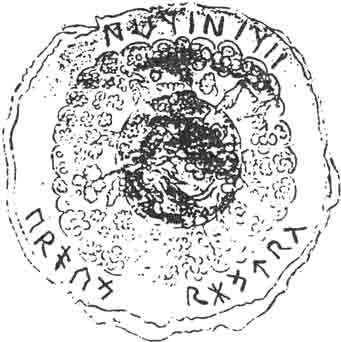
A published object from Retro by the archaeologist Pototsky, one of the inscriptions on which conveys the name of the god Prova, the West Slavic analogue of the eastern Perun. It also symbolizes personal power, but in some negative situations - power, not burdened with wisdom. But it is also a direct protection given by the gods from the forces of Chaos, from the destructive effects of psychic, material or any other destructive forces.
[E]. Key words: "Nature, Life, Movement". Rune of Life, or Alive, mobility and natural variability of being, for immobility is dead. This rune represents those divine forces that make grass grow, earth juices flow through tree trunks, and blood runs faster through spring in human veins. This is a rune of light and bright vitality and a natural desire for movement for all living things. Practical application: you can use this rune in cases when you are tired and do not feel lightness, desire and strength in yourself to move forward. In the Elder Futhark, this rune corresponds to the runes Evaz (Yew, Change) and Berkana (Birch).
[AND]. Key words: "Ice, Immobility, Fundamental". For a correct understanding of this rune, it should be remembered that in the Nordic Tradition, ice is one of the creative primordial elements, symbolizing strength-at-rest, potentiality, movement in stillness. According to some variants of northern legends, the World arose from a single hailstone - an ice grain. It should be remembered that the state of freezing, immobility, contains the potential power of movement and development (signified by the rune Yes) - just like the movement contains potential stagnation and freezing ... The state of immobility contains the potential strength of movement and development, just as movement involves potential stagnation and freezing. The sacred meaning of the rune: the accumulation of strength, energy and power for subsequent advancement. Practical Application: Rest before pushing forward. In the Scandinavian runic series, the rune of the Source corresponds to the Elder rune Isa (Ice) and, in part, the younger rune Hagalaz (Grad).
If you write in runes "Slavs" (Slavene), here's what happens:

Strength-Lelya-Alatyr-Wind-Is-Need-Is
With what each rune means, it turns out very significantly. Especially the ending:
Victory (Strength) - Love (Strength) - Beginning (Strength) - Strength (Life) - Life - Dedication - Life = Life.
It turns out interestingly with runes "North":
![]()
Force-Is-Wind-Is-Rainbow
Victory (Strength) - Life - Strength - Life - Joy (Road, Favorable outcome) = Life.
Vedic Culture is the basis of the Old Russian Faith! The Rus are the oldest of the civilized peoples on Earth. Slavism is the oldest and only world Faith on our planet. The main core of the Slavs is the Vedic Culture. All the peoples of the Earth belonging to the Caucasoid race are one mono-ethnic people, historically called "Ruses". Our truly Great Ancestors did not have the concept of "religion" in today's interpretation of this word. They didn't have to believe in anything. They knew how things worked and how things worked. Therefore, to believe in anything without any reason was unnatural for them.
Vedism is not a religion! It is a way of life, culture, mentality… But not a religion! A person can believe in God, knowing that he exists, or, feeling his presence in himself and in the world around him. Such faith is called Vedic. But faith can be forced on a person. Such a faith does not require a person to think, but imposes stupid blind worship, turning a person into a fanatic. With such faith, means are required for psychological pressure on consciousness in order to show man the greatness of "God" and the insignificance of man. This requires majestic temples and religious rites, that is, religion.
FAITH -modern sound Slavic-Aryan image, consisting of two runes:
-
rune "Veda"– “True Wisdom of the Almighty” – means “Knowledge”, i.e. the ability to Know Divine Wisdom, Tell it to others and, having become a follower of the Almighty, become a leader for those who want to Know His Truth.
- rune "PA"- means "The Radiance of the Truth of the Most High."
So, Faith is the Radiance of Wisdom and the Light of the Truth of the Most High.
Orthodoxy- the glorification of "Right" - the spiritual world of the Supreme Ancestor and His children - the bright Slavic-Aryan Gods and Goddesses, who are our Ancestors, and we are Their great-grandchildren.
Ynglism - the modern sound of the Slavic-Aryan image, consisting of the rune - "Inglia", meaning "The Primordial Fire of the Almighty", which generated the entire universe and the forms of Life inhabiting it, as well as the three-rune concept 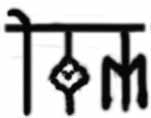 -
"ISM", meaning the Truth of the Earthly World.
-
"ISM", meaning the Truth of the Earthly World.
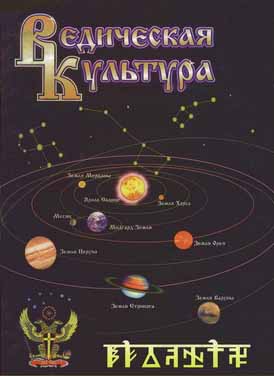
runic writing of the concept of "Vedic Culture" - the Truth of the Almighty.
The very name Ynglism has been forgotten and seems purely foreign. Inglia is the Divine Primary Fire, which gave rise to the diverse Life of the Universes. Ynglism is a Faith, not a religion, since the word religion means - the artificial restoration of the Spiritual connection between people and the Gods, on the basis of any Teaching. We do not need to restore the Spiritual connection between people and Gods, since this connection has not been interrupted for us, for our Gods are our Ancestors, and we are their children. All people with White skin color, living on different planets, are the One Universal Family, the descendants of the Heavenly Family and the Great Race, from which the White humanity of the planet Earth originates.
We, Russ, revere the Faith of the Genus of the Great Race, sent down by the Kind of Heaven. We keep Inglia - the sacred Divine Fire of our First Ancestors, and kindle it before the images and idols of the Gods and our Holy Wise Ancestors. We are Orthodox, since we glorify Rule, and Rule is the World of our Bright Gods. We are Slavs, for we glorify from the bottom of our hearts the Light Gods and our Holy Wise Ancestors. We must observe two Great Principles: "Holy honor the Gods and Ancestors, Always live according to Conscience!".
Ynglism does not belong to that Faith and those religions that you can accept, and then find for yourself a more interesting and better Faith or religion, believe or convert to it. It is also impossible, as, for example, to choose new life new Mother or new Father and be born from them. The departure from Ynglism at all times and among all Clans of the Great Race was regarded as a betrayal, as a renunciation of one's ancient Family, of one's Parents and Ancestors. Any tree whose roots are cut off sooner or later dries up and dies, so a person who renounces his Ancient Faith of the First Ancestors, his Parents, Relatives and Fatherland will inevitably come to death. Ynglism is the Ancient Faith of the First Ancestors and, in its original basis, does not carry anything against other peoples, beliefs and religions. It also does not carry anything anti-Christian, anti-Semitic and anti-Islamic. For Ynglism existed long before the advent of Judaism, Christianity, Islam and other religious teachings on earth. The original origins of Ynglism must be sought in the depths of antiquity, in the fertile and legendary country of Daaria (Arctida, Hyperborea), which was located on the sunken northern mainland.
Ancient Wisdom is learned not in order to dominate and command someone, and not in order to be reborn or exalted above other Clans. Ancient wisdom has always been learned in order to realize one's own life path in order to improve spiritually and in order to pass it on to their descendants.
Our gods: Ra (Ra-M-Ha), Genus-Generator, Svarog, Lada-Mother of God, Perun, Veles, Makosh-Mother of God, Dazhdbog, Svetovit, Yarila, Semargl, Tara-Mother of God, Kolyada, Kupala, Mara-Marena, Odin, Valkyrie, ...
Scandinavian runes Futhark.
Futhark is a Scandinavian runic system or row, i.e. a rigidly fixed list of runes, with their phonetic and magical meanings and names. Futhark contains 24 signs (plus an empty rune added during divination), divided into three groups - atta (att - "eight"); each att consists of eight runes. According to the phonetic correspondences of the runes of the first atta - f, u, th, a, r, k, ... - this system got its name - Futhark (Futark). They are also called Elder Runes. The runes have never remained the same. In the 5th century, runic writing and runic magic came to the British Isles - along with the Germanic tribes of the Angles and Saxons. British magicians and priests were not satisfied with Futhark and created their own runic system, which is a processing and addition to the original (Futark). These runes (there are 28 of them) are known as early Anglo-Saxon. Later, by the 9th century, another Anglo-Saxon runic system was created, containing already 33 characters - late Anglo-Saxon, or Northumbrian (Notumbria is one of the ancient Anglo-Saxon kingdoms in Britain) runes. As in the British Isles, in Scandinavia the runes also gradually changed, but the Scandinavian priests took the opposite path. Preserving Futhark for magical needs, they developed more and more runic alphabets, which were used almost exclusively as a means of writing. Thus, the first revised alphabets contained 16 characters similar in outline to the Futhark runes, the last ones (XI-XII centuries) contained 15 or fewer characters, sometimes having nothing in common with Futhark. In total, about a dozen alphabets were created in Scandinavia: a few in the Danish style and a little more in the Swedish-Norwegian. These Scandinavian versions of the Futhark are sometimes referred to as the Lesser Runes. Lesser Runes completed great amount inscriptions on memorial stones in Scandinavia; the total number of such stones, if conscientiously counted, will probably exceed three or four thousand. The vast majority of these inscriptions date back to the 11th century, are not associated with any magic and are purely memorial structures.
The similarity of northern Russian mythology with Scandinavian is curious. The unity of the region and the compact habitation of the Slavic-Aryans - Russ made itself felt in their mythology, in which Veles (Volos) corresponds to Odin - the Patron of priests, magic and poetry, a symbol of wisdom, spiritual insight, as well as connection with the Other world. Note that Odin in Scandinavia was revered higher than Thor, an analogue of the Slavic Perun. Russian philologists V. Ivanov and V. Toporov note: “It is noteworthy that the sorcerer spoke on behalf of Volos (an analogy in the words of the soothsayer in the Edda, pronounced on behalf of Odin).”
Scandinavian runic alphabet.
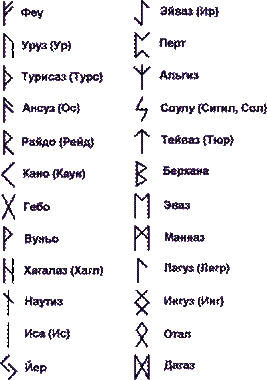
Feu - Fehu. Key words: "Cattle, Property". Rune of property. In the first, most common consideration - purely material property. However, working with this rune allows you to reveal its deeper properties, in particular, the connection with the property of the soul (but not spiritual - make a difference). However, one should not consider the relationship with the material world as something to belittle it - this is the main content. In general, it can be described not only as a rune of property, but also as a rune of well-being, not spoiled by self-satisfaction. The magical use of the rune is very wide and is associated mainly with material values. Inscribed on a ring or bracelet, it can help you get out of need by pushing you into certain situations and pointing out opportunities. Protects against mistakes when acquiring real estate and helps to maintain and improve. The same talisman can protect against trouble when transporting valuable goods. It must be borne in mind that, although this rune contributes to the preservation of well-being, including financial well-being, it is not directly connected with money and is unlikely to help in speculation and usury. In addition, there is an opinion that the Feu rune is able to provide some assistance in relations between a man and a woman. This, apparently, is true, however, before applying this rune to this problem, it is necessary to recall the scope of its action - the manifest world and the most gross manifestations of the subtle world, i.e. the physical, etheric and vital bodies of man. So there is something to think about.
Uruz (Ur) - Uruz [u]. Key words: "Bison". Rune of Strength. The area of action is the physical and subtle worlds, the causal (event) plan. This rune should not be understood as a rune of overwhelming power, but as a Force, all-encompassing and all-unifying. It is inextricably merged, like "yin" and "yang", the male and female components, and this rune gives men masculinity, women - femininity, and confidence - both. On the other hand, any connections can arise only where there is energy - a component of the Force; a powerless person can neither love nor be a friend. The second magical use of the Uruz rune is connected with this - it can help the emergence and strengthening of love and friendship, marriage or a partnership agreement.
Turisaz (Turs)-Thurisaz [þ]. Key words: "Thorn, Damn". Powerful, but very heavy rune. Energy of Saturn; color - black, sometimes crimson or deep purple. Gives strength and ability to reflect, focus and accept important decisions. Carved on a large obsidian ball, plate, etc., it is the perfect talisman for meditation.
Ansuz -Ansuz [a]. Keywords: "God". One of the most sacred runes. Energy Mercury. The scope is unlimited. The rune is associated with Odin, as well as with its reverse side - Loki, the insidious AS, dark and light at the same time. The magical application of the Ansuz rune is a complex matter, requiring experience and a certain amount of personal strength.
Raido - Raidu [r]. Keywords: "Way". Rune of the path. The scope is wide, mainly causal (event) plan. Bears the imprint of the energy of Mercury. Working with it is extremely effective for people who feel the beauty behind it, who live by the principle "the road is life." For these people, the Raido rune itself can serve as an excellent talisman. In addition, it is the rune of unification and harmonization, the rune of the final synthesis - but not completion as such. The use of this rune for purposes practical magic can be described absolutely clearly - this, as already said, is the rune of the path. If you have a journey ahead, the talisman with the Raido rune depicted will straighten and shorten your path, make it pleasant and protect you from unnecessary troubles. If you are embarking on a path of some other plan, the Raido rune will also support your strength.
Kano - Kauna [k]. Key words: "Torch". Rune of incarnation. Very powerful rune; is able not only to direct human activity (at any level) in the right direction, but also to give it the necessary strength. Ralph Blum* characterizes the Kano rune as "a rune of renewed clarity." The magical application of this rune is extremely wide, however, with proper analysis, it can be reduced to one thing - the Kano rune helps to concentrate the will and realize what was conceived. Women use amulets with the Kano rune inscribed on them during conception and pregnancy in order to give the child the desired qualities. Artists, writers, poets and other people of art can use this rune for the most clear and high-quality embodiment of their plans. An amulet with this rune can be recommended to both treasure hunters and magicians. It should also be noted that this rune has a second aspect - it is also a rune of disclosure. It is obvious that both aspects are interconnected - it is impossible to realize the idea without revealing oneself to the world. This is very important point, which should be remembered when working with this rune.
____________
*Ralph Bloom is an American modern author who has published several books on runes, including The Book of Runes, Healing Runes, Rune Maps. Bloom's books, each packaged with a set of ceramic runestones or a set of rune cards...
Gebo - Gebu. Key words: "Gift". Rune of unity. Together with some other runes (for example, Ansuz), the Gebo rune is one of the most difficult to process Futhark signs. To understand it, it is necessary to clearly feel the world law of unity and struggle of opposites, which are this case stand for freedom and partnership. A sincere and fruitful union is impossible where its members do not have complete freedom. Thus, the bonds of true brotherhood are always stronger than the forces that maintain the integrity of tyranny. But freedom, in the deepest sense of the word, is also impossible where "everyone pulls the blanket over himself." Associated with this content of the Gebo rune is a magical application, which is to help establish partnerships, whether it be marriage or a business venture. The rune will help in right choice partners and maintaining relationships.
Vunyo - Wunju[w]. Key words: "Joy". Light, joyful rune. Bears the imprint of the energy of Jupiter and Venus, the scope is too wide for a clear definition. The magical purpose is to cause joy, a surge of energy, a feeling of elation and good mood which is much more important than many tend to think. In some people, it can cause a beneficial cleansing of the astral body, the removal of energy blocks and an improvement in well-being.
Hagalaz - Hagalaz [h]. Key words: "Grad". Rune of Destruction. The scope of action is wide, mainly - the Subtle World and the causal (event) plan. Energy of Uranus and Mars; the color is pure scarlet, crimson, sometimes black. Associated with the natural forces of destruction, destruction, with the energies of the elements. During mass disasters, as well as during floods, earthquakes, volcanic eruptions, there are sharp and significant bursts of energy similar to the energy of this rune. The main magical use of this rune is to facilitate the exit from the vicious circle. The simplest example- familiar to almost everyone, painfully pleasant feeling of self-pity. Often a person spends hours and days savoring their own troubles, which is why they grow and block out the light. The state is energetically stable and therefore even more pathological. To realize that you have fallen into such a “vicious circle” and that you are in captivity of endless internal reflections own negative energy is a good three-quarters of liberation. And then, if you are not able to get out on your own, draw the Hagalaz rune - it will produce the necessary “explosion” and open the circle. By the way - if you see that another person is in a similar position, draw a rune for him: it will help him both to understand the situation and get out of it.
Nautiz - Naudiz [n]. Key words: "Need". Energy of Saturn. Complex rune. It supports a person in a difficult time for him - this is the main purpose, but at the same time it requires a certain restraint in emotions and actions and contributes to the manifestation of this restraint. Like most runes, it can be applied not only to any specially created amulet for her, but also to any suitable object (for example, to a fountain pen) or to a hand or nail.
Isa - Isaz [i]. Key words: "Ice". Rune of ice in the literal and figurative sense of the word. The scope is wide and covers all human bodies from the physical to the mental, and extends to the causal (event) plan. The main magical purpose of the Isa rune is to “freeze” anything. With its help, you can stop (but not eliminate) the negative process of illness (physical or mental), an outburst of anger (not only your own), some kind of phenomenon in public life etc. In some situations, it allows you to get the necessary respite.
Yer - Jara [j]. Key words: "Year, Harvest". Rune of completion. The rune names are obviously interconnected, both etymologically and in their meaning: it is the change of seasons, including the harvest period, that makes the very existence of the term “year” possible. On the other hand, the concept of the year symbolizes here full cycle development, culminating in its "harvest". The rune contributes to the successful completion of any important business; you can draw it before starting this business, cut it on an amulet or on an object directly involved in the business. In addition, this rune can also help if, already in the middle of the case, unexpected obstacles appeared that prevent its favorable outcome. It is necessary, however, to mention that the use of the Yer rune requires a person to apply personal strength and a certain amount of energy.
Eyvaz - [Ehwaz] e ]. Keywords: "Horse". One of the more difficult runes of the futhark. Magical application is based on the ability to assist in overcoming obstacles, both purely physical (for example, in sports), and mental or related to any activity. In addition, you can draw it when you want to give someone support and protection.
Perth - Peru [p]. Key words: "Death of the past, Search". Rune of initiation. Energetics of Pluto and Mars; the symbol of the inner content of this rune is the phoenix, i.e. rebirth through death in one's own fire. The energy contained in this rune is often owned by people, in natal chart whose Sun is in Scorpio. Rune Perth pushes and facilitates the process of a qualitative change in consciousness (inner initiation) - at any level. In certain situations, it can act like the Hagalaz rune, breaking off the closed chain of thoughts and the events they bring to life. The use of the Perth rune for magical purposes can lead to an act of psychic death - a rupture of causal and astral connections between the past and future of a person. In some situations, this can be beneficial, in others it will lead to an aggravation of the situations caused by it. Therefore, this rune must be used with reasonable care.
Algiz - Algiz [-R (-z)]. Key words: "Elk". Rune of protection. Some authors define it with the word "security", which has a slightly different meaning. With any definition, however, it should be noted that the protection here is passive in nature, although the rune requires a certain amount of personal strength from the defender. The use of the Algiz rune creates certain astral and causal (event) conditions that prevent the intrusion of external harmful forces - whether it be someone else's witchcraft or a brick falling from the roof. In this regard, the definition of "the rune of security" really turns out to be somewhat more accurate. In addition, the Algiz rune acts like "big-eyed" stones (cat's eye, tiger's eye), enhancing a person's ability to anticipate danger or someone's attack, and sometimes warning him in one way or another.
Soulu - Sowilu [s]. Key words: "Sun". Rune of Integrity. Bears the imprint of the energy of the Sun. Some authors tend to define the Soulu rune as the rune of the total, and in a certain sense this makes sense - indeed, integrity, the synthesis of opposites is the result of any movement. This is also the basis for the magical application of this rune, which can strive to achieve the integrity of a person or a situation. In addition, the Soulu rune can help you clarify an unclear situation and push you to the right decision.
Teyvaz - Tiwaz[t]. Key words: Tyr, Loss of energy. Rune of the Warrior. The energy of Mars in its purest manifestation, often with a hint of the Sun, Jupiter or Pluto. The scope of action is extremely wide and covers almost all worlds - from the physical to the fiery. Dedicated to Tyur (Tiv) - the god of war. Traditions tell about one deed of this AS, which remarkably characterizes both himself and his rune. Once the gods managed to catch Fenrir, the World Wolf - the cause of the coming Ragnarok (End of the World). In order to contain the destructive power of the Wolf, it was necessary to impose on him the strongest fetters specially made for this purpose. But the Wolf, of course, did not give in, and then Tyr put his hand in his mouth as a pledge that the fetters would be removed! And when the Wolf was chained, he bit off Tyr's hand - but the victory over Chaos was achieved. As if in memory of this act of Tyr, the Teyvaz rune keeps the ability to help people in any of their struggles, but above all, in their struggle against the forces of Chaos of their own "I". In ancient times, warriors drew this rune on shields and sword hilts, and drew it before battle in order to strengthen their resolve.
Berkana - Berkana [b]. Key words: "Birch". Rune of growth. Energetics of Venus, with many shades and overlays; Green colour. The scope of the Berkan rune is extremely wide; the growth symbolized by it can be both purely physical and spiritual. This is the rune of fertile movement, leading to flowering and maturation. The magical use of this rune is also based on this. It can serve as both a fertility stimulant in general and a growth stimulant in particular. Promotes birth and rebirth. It can help with solving problems related to raising children, as well as facilitate childbirth and heal from infertility. Do not forget about the purely physical manifestations of the action of this rune.
Evaz - Iwaz [é (ih-wh)]. Key words: "Yew, Changes". Rune of changes (movement, progress, shift from the dead center). The sphere of action is the astral and causal (event) planes. Bears a strong imprint of the energy of Mercury; Green colour. Magical application follows from the definition itself - the rune is used to change, “stir up” something that has entered the stagnation phase. This something can be some kind of situation, a stuck business, and a chronic illness, and, finally, a person who has fallen into mental lethargy or is fixated on some insoluble problem. In this regard, we can say that the Evaz rune works exactly the opposite of the Isa rune. Another aspect of its action is to facilitate the path of travelers (especially those who travel by water, they say).
Mannaz - Mannaz[m]. Key words: "Man". Difficult rune. Ralph Blum defines it as the rune of his own "I". Bears the imprint of the energy of Saturn. The use of the Mannaz rune for magical purposes is ambiguous and requires the application of a significant amount of energy.
Laguz - Laguz [l]. Key words: "Lake". Difficult but wonderful rune. The classical translation of the name ("water") does not accurately define its content. The name of this rune implies not just water, but flowing water, moving water - the one that forms the stream and drags along. The rune bears the imprint of the energy of Mercury. Rune Laguz is the rune of intuition, and magical applications are associated with this. Use sharpens and enhances the intuitive perception of the world, helps in the study of the occult sciences and in penetration into the secret - this is one aspect of the action. On the other hand, the rune promotes marriage, the formation of a new friendship and the restoration of an old one, the cessation of a quarrel or quarrel.
Inguz - Iŋwaz [ŋ]. Key words: "Yngwie, Fertility", Completion". One of the finest and most powerful Futhark runes. The rune of fertility in its reproductive aspect. The scope of action is wide, it covers the physical and Subtle worlds and the causal (event) plan. Energetics of Venus with many shades and variations; Green colour. The rune is dedicated to the bright Freyr, the god of fertility (his other name is Ing or Yngwie). The magical use of the rune Inguz is associated with the forces of light Freyr; in fact, the use of this rune is a direct appeal to this god. The rune can be used wherever there is a lack of natural fertility forces: in the case of female infertility or male impotence, poor land or barren work. Also, the Inguz rune is able to relieve excessive stress and restore the balance (balance) of the vital forces of a person *.
_______________
* Into three main (initial) groups of human needs - vital, social, ideal – noticed for the first time the outstanding Russian writer F.M. Dostoevsky. When people speak of the vital man they mean a man who is under the influence of a vital force which is not controlled by the mind or spirit. Vitality is the vital force inherent in any form of manifestation of life, in a plant, animal or person. Where there is life, there is life force. Without vitality there can be no life and its manifestation in matter. The vital proper is the life force acting within its own nature, impulses, emotions, feelings, desires, aspirations, etc.
Othal - Oþila [o]. Key words: "Legacy, Rejection and Acquisition". The literal meaning of the rune is property, inheritance. The energy of Saturn, sometimes with the imprint of Mercury or Uranus. The rune speaks of the need to abandon everything old, obsolete. Shake the dust from the boots of all your wrong previous conclusions and come to accept the legacy that awaits you. It's time to learn about the hereditary heritage that genetics has prepared for you, and spiritual kinship, and possibly the continuity of traditions, practices, business, etc. Runa Otal (Odal) - a very good sign. He points out to you that noble blood flows in your veins, that you are attached to a high-born tree, and you just have to accept it with gratitude and study everything that this circumstance requires. You may have to break old bonds to hold your new position. Do it abruptly, but as nobly as possible, so as not to disrupt the flow of energies in a positive way.
Dagaz - Dagaz. Keywords: "Day". A very light rune, the area of effect is extremely wide. Bears the imprint of the energy of the Sun and Jupiter; color - often gold (not yellow). Combines two global interrelated concepts. In terms of the first of them, the Dagaz rune can be defined as a rune of transformation. In terms of the second - as a rune of prosperity. Both concepts are combined in the magical application of the rune - the approach of the end of the period of darkness ("night") and the beginning of the period of light and prosperity ("day"), the implementation of a breakthrough in any business or moving it off the ground. It can also be used in the treatment of chronic diseases.
Rune origin. On the problem of the origin of runes, there are currently a large number of hypotheses: the Greek-Latin version; Semitic version; an unconventional version of Agrell, a Swedish professor at Lund University who put forward an esoteric theory in 1932; mythological version - according to Scandinavian mythology, the runes were revealed to God Odin (Veles) *; North Etruscan version.
________________
*One (Wotan, Veles)- in Scandinavian mythology, the Slavic-Aryan supreme god - wisdom, witchcraft, magic spells and poetry. God-Warrior, together with his brothers, he equips the earthly world and creates people.
The North Etruscan version is the most popular, which suggests a theory about the origin of the runic script from one of the North Etruscan alphabets, which was proposed in 1928 by the runologist Marstrander. This version supported by most scholars. There is a theory about the mixed origin of the runes from the North Etruscan and Ogham alphabets, it was proposed by the Scandinavian researcher Hammarstrom, and also, according to the researcher Feist, in addition to these two scripts, the Latin script could have influenced the runes.
North Etruscan or Alpine alphabets - 5 alphabets derived from Etruscan and used by various languages in the Alps. In total, 5 different North Etruscan alphabets are distinguished, according to the place where the inscriptions were found: the Lepontian alphabet - inscriptions from Lugano; alphabet from Sondrio; alphabet from Bolzano; alphabet from Magre; Venetian alphabet - inscriptions from Venice and Este. The earliest is the Venetian alphabet, the inscriptions on which date back to the 6th century BC. e. The latest inscriptions date back to the 1st century BC. e., that is, by the time when the Etruscan alphabet proper had long since fallen into disuse. The North Etruscan alphabets take their origin from an early version of the Etruscan alphabet. The direction of the letter was varied: both from left to right and from right to left. The Lepontian alphabet - inscriptions from Lugano, or, as it is also called, Ligurian-Celtic, since the Lepontian tribe was probably of mixed Celto-Ligurian origin.
It should be remembered that our Slavic-Aryan ancestors - Russ, with the help of symbols and images developed over many tens of millennia, provided the specified accuracy in modeling world forces and structures, in unity various areas being. From these mono-symbols, the Swastik symbols were built, which became the basis Old Russian alphabet and origins of world culture. Therefore, it is the Russian Language that is the base, the main trunk, from which all other languages have spun off.
The swastika is a product of the centuries-old intellectual activity of the Russian people, and the system of swastika symbols is the most ancient on Earth and the most developed writing system, which gave rise to both Runic writings and Hieroglyphic and, later, Letter writing!
Today, runes are largely used as mystical symbols for divination, "enchantment" of objects, in tattoos and amulets. For divination, a set of 18/24 or 19/25 Slavic or Scandinavian runes is used, respectively. Also used is a set of 28/33, known as early and late Anglo-Saxon runes. By the 9th century, another Anglo-Saxon runic system was created, containing already 33 signs - late Anglo-Saxon, or Northumbrian (Notumbria is one of the ancient Anglo-Saxon kingdoms in Britain), runes. As in the British Isles, so in Scandinavia, the runes also gradually changed.
As a rule, runes are applied to stones, but fortunetellers often use runes made of wood, bone and metal. Each rune in magical practice has its own meaning. We have already considered this before. In modern practice, the 19th, 25th or 33rd rune of Veles (Odin) is also used, an empty rune (that is, an empty fortune-telling blank for a rune), which means “pure fate”. The runes are put in a special bag, which should always be carried with you. It is worth getting the runes out of the bag only at the moment of divination. There are many different ways of divination with the help of runes, but this is not the topic.
It should only be noted that everything must be taken seriously, especially magic. Once upon a time, hypnosis, parapsychology and many other magical phenomena, which are still plentiful, scientists, global community, attributed to nonsense and "magical quackery". But time passed and these areas of magical achievements turned into science. Of course, now there are a lot of people who consider themselves magicians, but in reality they are not, and thereby harm themselves and those around them. The true meaning of natural magical phenomena is revealed before reasonable person only when the brain of a true scientist builds a given pattern in modeling world forces and structures in the unity of Life and Cosmos.
runic magic allows you to control various energy flows coming from the cosmic spheres. To do this, you need to create the appropriate conditions for your physical body, that is, take the correct runic posture and adjust your consciousness to the perception of energy flows. This is done with the help of special runic sounds, which are called “spell”, “magic song”.
Our Russian scientist, philosopher, historian, Doctor of Philosophy, Academician of the Russian Academy of Natural Sciences V.A. Chudinov is engaged in the study of the cryptographic heritage, encrypted in the remains material culture ancient civilizations. His remarkable works are scientifically based and aimed at proving the existence Slavic runes. Many of his works, claiming to be discoveries, are undoubtedly important for Russian civilization. After all, the Slavic Vedic Culture arose long before all other known civilizations. Works that make the era of the emergence of a specifically Russian (not even Proto-Slavic) language are also important, since a lot of such facts and evidence have already accumulated. It is also important that V.A. Chudinov conducted research and corrected the table for deciphering the Etruscan script proposed by Thaddeus (Tadeusz) Volansky. The results of both are broadly the same: The Etruscans spoke the Slavic language! Here is a confirmation of one of the versions of the origin of the runes - Etruscan - Rusov!
Traces of Slavic runic writing have been found and are described on monuments - Sungir, near the city of Vladimir, Kostenka, near the city of Voronezh. B. A. Rybakov, the largest Russian archaeologist and historian of the 20th century, academician of the Academy of Sciences of the USSR and the Russian Academy of Sciences, established that “a rhombic ornament is depicted on the chest of the Paleolithic statuette of the Slavic goddess Makosh, which is confidently identifiable with Slavic symbol“Unsown field”, which belongs specifically to the Slavic goddess Makosha, and on the back of this figurine are inscribed completely modern letters». The most ancient letters inscribed on the sculpture of Mokosh 42 thousand years ago! finds on Southern Urals"Country of Cities", Arkaim - the Slavic-Aryan City-Fortress, dated 4 thousand years BC. and others, of which dozens have been discovered on the territory of Russia, categorically testify that the ancient Ruses possessed not only the knowledge of astronomy and mathematics, but also conducted a calendar calculation using both solar, lunar, and combined calendars, had their own ancient Russian calendar. They possessed agricultural technologies, design and construction technologies, as well as highly developed metallurgy and metal processing techniques. And it would be ridiculous to say, with such modern knowledge of our ancestors Russ, which is the basis of many other sciences, that the Slavs-Rus did not have their own alphabet and script. We must forever forget this Judeo-Christian nonsense that the clergy "Cyril and Methodius invented writing for the Slavs." This anti-Russian propaganda must be stopped. It is proved that in many artistic monuments of antiquity, the Middle Ages and later times, there are encrypted Slavic texts. According to research, many scientists Slavic Vedism in Rus' coexisted with Christianity before Nikon's reforms, and Russian runic cryptography was used in places until mid-nineteenth centuries (and even beyond) "dedicated" (A.S. Pushkin, V.M. Vasnetsov, Jean Cocteau, and others). Slavic runic inscriptions have been discovered by archaeologists on thousands of historical objects. Among them are ancient sanctuaries, sacred stones, objects of worship, utensils of ancient and pre-antique times, letters, Christian icons of the first centuries and other artifacts.
We believe in our Russian scientists, we believe in our Russian people, and we are proud of our great ancestors, who were the founders of the Runic alphabet and writing on Earth.

Hello Sunny - My Light!
I send you my greetings!
I love you always!
You warm me loving!
We are Russ - the grandchildren of Dazhdbozhia - the grandchildren of the Russian Gods!
We must solve all the problems in Our Life Calmly, Confidently, Joyfully and with Love.
We are in agreement between ourselves and Harmony.
Let's help Our relatives and friends Russ, Our Native Russian People, so that everything would be fine for all of Us, so that we would all be Healthy, Happy and Free.
We will overcome all difficulties and obstacles.
We will overcome all enemies and enemies.
Let's bring Russ to power in Russia!
Let's revive Rus'!
Let's Revive the Faith of Our Gods and Our Ancestors - Russian Vedic Culture!
Let's revive Rule in Russia and the World!
Glory to Our United Russian Family!
Images are the origins of world culture”, “ Runic alphabet Slavyano-Aryans», « Slavic month May - Traven... the formation of early capitalism. His often called western civilization But... which is also part world government. World leaders...
Futhark and termsOld Norse and Anglo-Saxon run, Old Norse runar and Old German runa are related to the Germanic root en and gothic runa, meaning "mystery", as well as the Old German runen (modern raunen), meaning "mysteriously whisper". This name, apparently, is due to the fact that the ancient Germans attributed certain mystical properties to the runes.
Side of a runestone from Denmark. The inscription reads like zusi: kubl: ub: biruti, which translates as "The sorcerer will be the person who destroys this monument"
The Elder Futhark is the main, all-Germanic runic system. To date, it is generally accepted that it arose by the beginning of the II century and lasted until the VIII.
There are all-German runes - "senior", Scandinavian - "younger", and Anglo-Saxon runes.
The oldest runes are known as the "elder futhark" - this name comes from the first six characters runic alphabet
F-U-Th-A-R-K

The modern version of the Elder Futhark, unlike the ancient one, has the following assumptions:
1. Rune graphemes are standardized - although in reality this has never happened.
2. Rune names have been standardized - although, most likely, they were never called that way.
3. Standardized the order of runes in Futhark - although there were also several options.
Home distinctive feature the runic alphabet is the order of the letters. Such an alphabetical order was not found in any other script.
The alphabet was divided into three genera (Isl. Ættir - ettir, Norwegian Ætt - att), 8 runes in each.
The first ettir included runes f, u, þ, a, r, k, g, w.
In the second - h, n, i, j, é (ih-wh), p, R (z), s.
The third ettir included runes t, b, e, m, l, ?, d, o.
Each rune had its own name. The original names of the runes have not survived, but here are their conjectural names, restored from the names of the runes in later alphabets:
| Rune | Name | Translation | Transcription |
|---|---|---|---|
| 1 ettir | |||
| Fehu | "cattle, property" | f, v | |
| Uruz | "bison" | u | |
| Jurisaz | "thorn, damn" | þ | |
| Ansuz | "God" | a | |
| Raidu | "path" | r | |
| Kauna | "torch" | k | |
| Gebu | "gift" | g, γ | |
| Wunju | "joy" | w | |
| 2 ettir | |||
| Hagalaz | "grad" | h | |
| Naudiz | "need" | n | |
| Isaz | "ice" | i | |
| Jara | "year, harvest" | j | |
| Iwaz | "yew" | e (ih-wh) | |
| Peru | The meaning is not clear | p | |
| Algiz | "elk" | -R (-z) | |
| or | Sowilu | "Sun" | s |
| 3 ettir | |||
| Tiwaz | "Tyur" | t | |
| Berkana | "birch" | b | |
| Ehwaz | "horse" | e | |
| Mannaz | "Human" | m | |
| Laguz | "lake" | l | |
| I?waz | "Yngwie" | ? | |
| Dagaz | "day" | d, ð | |
| Oþila | "heritage" | o | |
The direction of writing is from left to right, but boustrophedon is found in early inscriptions. So, on a spear from Kovel, the inscription is read from right to left, and the runes themselves are also turned in reverse side, like North Etruscan letters and Greek letters in the early monuments of ancient Greek writing. Words were separated by periods, colons, or crosses.
The natural order of the runes
The sequence of runes in their natural order differs from the so-called traditional construction not only by the movement of the PU rune to the point of culmination, but also by the rearrangement of some other runes. PETRAS and YO change places, the same thing happens with ODAL and DAGAZ.
The alphabetical order of the Futhark runes was intended primarily to disguise their original sequence. According to oral tradition in modern Sweden, the original order began with the UR, U-rune, and ended with the FE, F-rune. In fact, “beginning” and “ending” are also not entirely correct terms, since the runes were originally arranged in a circular or spiral, and not in a linear sequence, where the “last” member of the series was directly adjacent to the “first”. Each rune had its own serial number. PU can be compared to an ace in a deck playing cards, giving the highest or lowest number of points, depending on the rules of a particular game. The Futhark order corresponds to card game, in which the ace gives the largest number points, so UR counts as one and PU equals 24. Many of those who studied runes in the Futhark system might wonder, like me, why the first rune should be associated with the culmination of wealth and power, while the second rune is associated with primary substance or potential. In my opinion, the order of the sequence is clearly violated here. In the natural order, UR R is the primary potential, followed by everything else, and PU is the rune of fulfillment and completion, as I will demonstrate shortly.

Runes arranged in a circular, or cyclic, order.
The Futhark order of the runes also had magical significance. They were divided into three groups of eight runes; binary code indicated in which figure eight the rune appeared, and determined its position in the group. In other words, it was an order that put the Mind above all else, to draw power from the Will and make changes in order to satisfy the Ego.
The Uthark order is a natural and original system that reveals the process of creation of the Universe and the various qualities inherent in its manifestations, because it emphasizes the activity of the Spirit.
Thus, the runes reveal the very process of creation and the qualities inherent in nature and ourselves.
Runic shamans have always treated the Futhark order with care and respect, prompted by Love and Harmony. They contributed to the runic power; their common intention was to bring harmony and order, to avoid; intentional harm, regardless of the purpose for which the runes were asked. The main goal of what we can call "personal development" was the cultivation of the Spirit - the innermost "I" - and the well-being of the whole person.
Uthark order of runes and their meanings
24 statutory styles with their names, letters of the alphabet and place in a natural sequence.


The first runes UR, TERS, ASS and KEN contain the potential activated in the first phase of Creation and work at the deepest levels of the subconscious, generating creative forces that create the whole world of phenomena.
U-rune, UR

At the beginning of all things was the great primary Chaos, which the northern peoples called Ginnungagap, which was the "space" between two extremes or opposites: Fire and Ice, Yin and Yang. UR symbolizes Chaos, the primary material of creation. The inscription of the rune resembles the horns of a cow, lowered down when she grazes in a meadow. This rune is also the symbol of the sacred mythological cow Audumbla - which means "nurse" - a powerful, primary creative force created from the first mixture of Cosmic Fire and Ice, Yin and Yang. According to the myth, in the “womb” of Ginnungagap, an androgynous giant was born, named Umr, and fed by the milk of Audumbla. This act symbolizes the alchemical process of evaporation, condensation and purification; this is how the power of UR works
T-rune, TERS

Is the primitive force that formed the Umrah. "Ters" really means "giant" or "strong man". In Norse myths, Umr was the father and mother of the gods, the entities that control and direct the natural forces that operate in a gradual process of organic development.
A-rune, ACC

Is a creative force. In northern myths, three gods - Odin, Vili and Be - defeated Umr and created the Universe as we know it from his body. The word "ace" means "god", and in the Anglo-Saxon dialect it also means "mouth". It is the power that breathed in the word of Creation that created physical reality; power that manifests the Unmanifested.
R-rune, REID

It is the power of movement and order expressed in the four directions and the four elements. Therefore, it is the fourth rune. In legend, it is considered the rune of Thor, the god of thunder and lightning, since Thor personifies the power that prevents the Cosmic Order from returning to the original Chaos. It is the protector of order and the creator of laws. R-rune - illuminating power; lightning that brings sudden flashes of inspiration. It is also the power of direction and movement contained in the first phase of Creation.
K-rune, KEN

Fire is born from lightning, and K-rune, KEN - personifies spiritual fire, clear and bright, like the flame of a torch, with which it is sometimes associated. This rune is the illumination of the Spirit, illuminating the path. This is the energy of light, coming from the “inner” fire and making any accomplishments possible.
G-rune, GIFU

Symbolizing the six directions and the center of the universe. It is the power of harmony and balance. The statutory mark reflects an equal exchange of energy between various directions. This is the divine gift of Life - the giving and receiving of life force.
W-rune, VINA

The power of joy resulting from the exchange of energy. It is the joy of satisfaction and completion that accompanies orgasm. Therefore, it is the seventh rune, for seven is the number of perfection.
N-rune, HAGAL

Represents the rainbow, or the bridge between the worlds. With it, we are approaching the material world, since this rune serves as the completion of the first octave and at the same time the transition to the next. This is the rune of the primary crystal, which contains all the colors of the spectrum and carries the potential for realization, like a DNA molecule in a human cell. The N-rune can also be represented by the snowflake symbol representing the eight directions.
N-rune, NIID

With the NIID rune, entities appear that weave the Network of the Universe, spin the thread human life. These entities in mythology were represented by three goddesses or Norns: Urd (what-is), Verdandi (what-becomes) and Skald (what-should-be). Norns are usually defined as Past, Present and Future, but it should be taken into account that this division of time is a historical concept. Western culture that arose under Greco-Roman influence. The shamans of antiquity had a completely different idea of time; they saw it as a tightly intertwined unity, the ever-changing Now, flowing from what was to what is coming into being. In this understanding, everything that has ever happened is still active and affects the present, in which the future is being formed. The statutory mark of the N-rune looks like two sticks folded to make fire. It denotes the force of friction and the need for resistance inherent in the energy of this rune.
I-rune, ISS

The tenth rune of the ISS - a force that slows down energy vibrations and condenses the structure of matter. It has the properties of clarity and massiveness, and therefore is sometimes identified with ice.
The first ten runes denote the primary Creation and the forces that create the inner spiritual structure of the Universe. The next ten runes refer to physical manifestations.
Y-rune, YARA

Starting with the Y-Rune YARA, we enter the world of "ordinary" reality for the first time. The word "yara" means "year", since this rune is a cyclic force, as well as energy that gives birth and sustains life. The statutory inscription symbolizes the seasons of two half-years, summer and winter, constantly interacting with each other. Summer harvest is winter food; seeds hidden in the ground with the onset of winter germinate by the beginning of summer. Thus, the Y-rune is the power of translating intention into a tangible result.
The next three runes are associated with the mineral, plant and animal kingdoms.
R-rune, PETRA

The energy of transformation that is present in earth minerals, metals, such as iron, which can be absorbed into thousands of things, yet remains iron. It is the binding force that keeps things strong and stable.
El rune, yo

Growth energy supporting wild plants. It is present in the cerebrospinal fluid, which gives strength to the spine. Possesses qualities of flexibility and endurance.
Z-rune, OLGIZ
![]()
An instinctive protective force prevalent among wild animals. It provides the intention of survival.
S-rune, SOL

Meaning "solar force". This is the energy of the spiral development of life and light vibrations, as well as an energizing factor at the birth of the “light” of consciousness in the process of personality isolation.
Then there are human beings.
The human element appears in the plan of Creation along with the T-rune TIR (male) and the V-rune BYARKA (female). They also represent heaven and earth, Heavenly Father and Heavenly Mother.
T-rune, TIR

It is a male force, expressing courage, decisive action, power and pressure. It has the shape of a spear - a symbol of determination and the intention to succeed.
V-rune, BJARKA

A symbol of female power that nourishes, cherishes and protects. This maternal strength Earth, expressing unconditional care and support. The rune is shaped female breast symbolizing love, beauty and nourishment.
EH rune

It can be seen as communication or connection of the feminine and masculine. This is the power inherent in ecstatic uplift. She also represents the energy experienced in the shamanic "journey" - an altered state of awareness that allows one to explore other planes of reality. This rune is sometimes associated with a horse, since in Norse mythology Odin's steed Sleipnir transported him to other realms of existence. It has the property of cohesion.
M-rune, MADR

In the M-rune, MADR, this binding force manifests itself most deeply. This creative interaction is the basis of unity and harmony. The same force brings together the activity of the right and left hemispheres of the brain, provides their mutual support, so that the intellectual faculty of reason and intuitive insight develop harmoniously and harmoniously.
L-rune, LAGU

The power of fluidity. This is the force that drives the lunar tides and energy flows of all kinds. The L-rune marks the end of the next cycle of the runic sequence.
ING rune, ING
Considered a symbol of fertility. At the same time, it is an impulse moving from physical existence to the Cosmic. This is a comprehending power, the ability to perceive and realize the new.
O-rune, ODAL
It is the force that makes us human beings. It is inherited, and we carry it with us from previous lives. Sometimes it is associated with heritage and a sense of security found in tradition and under one's own roof.
D-rune, DAGAZ
inscription D-runes, DAGAZ similar to a butterfly and symbolizes the ability to overcome one's own limitations - like a butterfly crawling out of a cocoon and taking on a different form, with a wider perception. This rune contains the transformative power of enlightenment, heralding a new dawn of spiritual awareness.
F-rune, FE
With the F-rune, PU, we are approaching the final stage of Creation. It is the ability to accomplish everything for which we came into existence in this life. The rune symbolizes the end, but when we reach it, we find that this is not the end, but a new beginning. The F-rune is next to the U-rune, and both have a cow as their symbol.
Rune origin
Some historians claim that the runes originated in the Teutonic tribes Northern Europe in the 5th century BC e.
Others are of the opinion that the Scandinavian Goths adapted the Greek script during their contact with Hellenic culture around the 2nd century BC. AD
Still others suggest that the runes arose much later, in northern Italy, and are derived from the Latin alphabet. There is an opinion that they were invented by the Vikings in the VIII century. n. e.
But although the views of scientists differ on the issue of the origin of runic writing, most agree that the runes were used by pagan tribes in the vast expanse of Northern Europe. Many of these tribes were descendants of the Teutonic peoples, whose mythology and theology is most fully expressed in later texts known as the Eddas. These loosely related poems, songs and texts were collected together in the Codex Regius (Royal Manuscript), so named because it was kept in the Royal Library of Copenhagen until 1971, and then returned to its homeland, Iceland. This manuscript is from the thirteenth century. It was compiled more than 200 years after the conversion of Iceland to Christianity.
The Elder and Younger Eddas were attempts to preserve on paper the living word of the ancient poets, who depicted in allegorical form the eternal struggle between the beneficent forces of nature and the hostile forces of Chaos. Perhaps not everyone understands that the events described in these texts are related not so much to the origin, but to the rediscovery of the runes, comparable only to the "runic revival" of our days.
According to oral tradition, runes have much more long history than is assumed in modern scientific works.
Vikings
In the culture of the Vikings, which flourished from the VI to the XII century. n. e., runes were widely used. The word "Viking" is translated as "traveler" or "pioneer". This Scandinavian people became famous for the exploration of vast sections of mainland waterways and long-distance sea voyages in sailing galleys or drakkars, very advanced ships for that time. Shamans often accompanied the Vikings on their travels, spreading knowledge about the runes, myths and legends about their origin.
What is hidden under the myth?
A myth is an attempt to explain in allegorical form how life originated and developed on our planet, how the events of past eras influenced humanity. Illiterate people memorized myths and passed them down through oral tradition from generation to generation.
Mythology is an unscientific way of explaining the origin of the universe and the relationship between the fundamental forces of nature. Myth expresses in poetic or narrative form certain basic principles rather than literal truth, and thus appeals to intuition rather than common sense, and stimulates the senses rather than the intellect. The difference between myth and legend is that myths tend to be about non-ordinary reality, while legends in question about human activity in the conditions of ordinary reality. Perhaps the myths are part of the racial memory of a previous civilization and are presented in a form accessible to the descendants of those who survived the global environmental catastrophe. In the veryCase: The Holy Scriptures also contain references to a prehistoric civilization that was destroyed as a result of an environmental disaster. An example is the Old Testament tradition of Noah's ark.
In the myths of the Elder and Younger Edda, the runes are presented not as a human invention, but as something already existing, waiting only to be discovered and released. It remains unclear whether Odin received them in divine form, or in the form of a man, subsequently deified for his merits.
Runes and Odin
In the poem "Havamal" (the title means "Song of the High") from " Elder Edda» 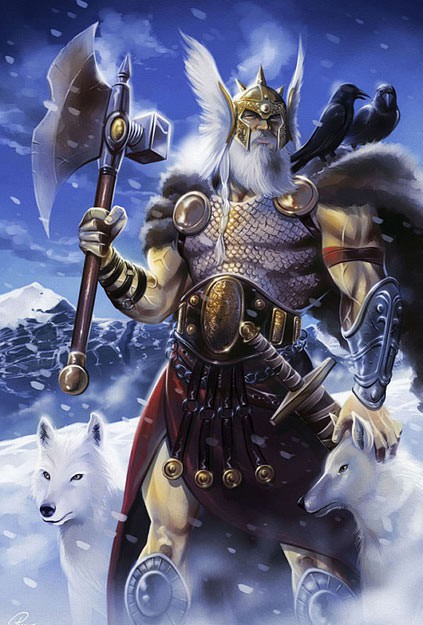 tells how Odin, in an attempt to do something valuable for people, voluntarily hung upside down for nine days without food or drink, nailed to a tree with his own spear. As a result, he lost an eye, but gained the runes that were revealed to him as a gift to humanity from the unusual reality of shamanic experience. The runes provided a means of gaining knowledge about the secret forces of nature and the processes that underlie being. They expanded perception beyond the physical senses, allowing them to "see" the Spirit with their inner vision and "hear" the inaudible. The transformation of personality is made possible because the runes themselves are a great transforming force.
tells how Odin, in an attempt to do something valuable for people, voluntarily hung upside down for nine days without food or drink, nailed to a tree with his own spear. As a result, he lost an eye, but gained the runes that were revealed to him as a gift to humanity from the unusual reality of shamanic experience. The runes provided a means of gaining knowledge about the secret forces of nature and the processes that underlie being. They expanded perception beyond the physical senses, allowing them to "see" the Spirit with their inner vision and "hear" the inaudible. The transformation of personality is made possible because the runes themselves are a great transforming force.
The following poetic passage about Odin's experience is taken from the Poetic Edda (c. 1200 AD), translated from Old Norse:
Hanging from this tall tree
Hanging out there nine long nights
Wounded by my own blade
Bloody for Odin
Sacrificed to himself
Nailed to a tree
Whose roots go into the unknown.
Nobody gave me bread
Nobody gave me a drink
I looked into the deepest abysses
Until I tracked down the Runes.
With a shout of victory I seized them,
Then darkness enveloped everything.
I got the blessing for everyone,
And wisdom too.
From word to word
I was led to the Word
From act to act.
Why did Odin hang upside down from a tree? This question is usually ignored by those who write books about runes, but Odin was clearly trying to convey some important knowledge with his gesture.
The legend of Odin hanging from a tree bears similarities to the crucifixion story in the New Testament. Christianity was acceptable northern peoples largely because Jesus' agony on the cross reminded them of the suffering of Odin, nailed to a tree with a spear. But with the difference that Odin hung upside down!
Such a choice can be seen as a conscious act of the martyr,  ready to sacrifice his life for the sake of achieving truth, as the willingness to give up his "ego" in order to gain wisdom and understanding. Odin's gaze, hanging from the tree, was turned to the roots. This can be interpreted as a vision of the depths of the Subconscious, where the potential of all phenomena is laid, or as a transition from the external activity of physical existence to peace and renewal, preceding rebirth. Odin's self-sacrifice, his rejectionhis "I" for the benefit of the Higher Self, could serve as an impetus for a sudden flash of inspiration - that inner insight that allowed him to comprehend secret meaning runes. But it could also mean something more.
ready to sacrifice his life for the sake of achieving truth, as the willingness to give up his "ego" in order to gain wisdom and understanding. Odin's gaze, hanging from the tree, was turned to the roots. This can be interpreted as a vision of the depths of the Subconscious, where the potential of all phenomena is laid, or as a transition from the external activity of physical existence to peace and renewal, preceding rebirth. Odin's self-sacrifice, his rejectionhis "I" for the benefit of the Higher Self, could serve as an impetus for a sudden flash of inspiration - that inner insight that allowed him to comprehend secret meaning runes. But it could also mean something more.
Although there is a certain affinity between humans and trees, their functions and characteristics are opposite. For example, tree leaves absorb carbon dioxide from the atmosphere and release oxygen. Humans, on the other hand, breathe in oxygen and release carbon dioxide. The roots of trees are in the ground, and their reproductive system - flowers and fruits - is located at the top of the trunk. The reproductive organs of a man are at the base of his torso, and the “stem” and “roots” are in his head, because although the food for the physical body comes from the Earth, the source of life is in the Universe. The center of a person's mind is located in his head, and through this center the development of personality is realized. Micho Kushi, in his Book of Macrobiotics, writes: "It would be more accurate to say that we are hanging from the heavens than we are standing on the ground."
Thus, Odin, through his shamanic experience, demonstrates that our 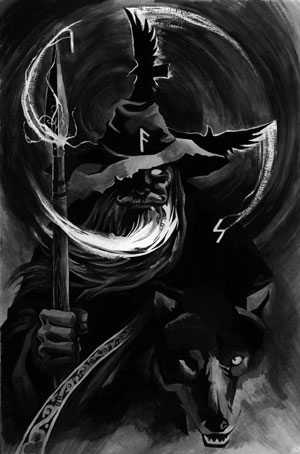 "roots" are brain cells, and our body, being a physical object, has a primary spiritual nature, and we are, as it were, suspended between these two states. One in allegorical form expresses understanding of the energy nature of man and teaches us that the purpose of human life is the harmony of the forces of Heaven and Earth, the balance of the body, mind, soul and Spirit. He shows that although in the physical reality development is directed outward, in the reality of the Spirit development is directed inward, towards our seed and source, towards the merging of the physical and the spiritual.
"roots" are brain cells, and our body, being a physical object, has a primary spiritual nature, and we are, as it were, suspended between these two states. One in allegorical form expresses understanding of the energy nature of man and teaches us that the purpose of human life is the harmony of the forces of Heaven and Earth, the balance of the body, mind, soul and Spirit. He shows that although in the physical reality development is directed outward, in the reality of the Spirit development is directed inward, towards our seed and source, towards the merging of the physical and the spiritual.
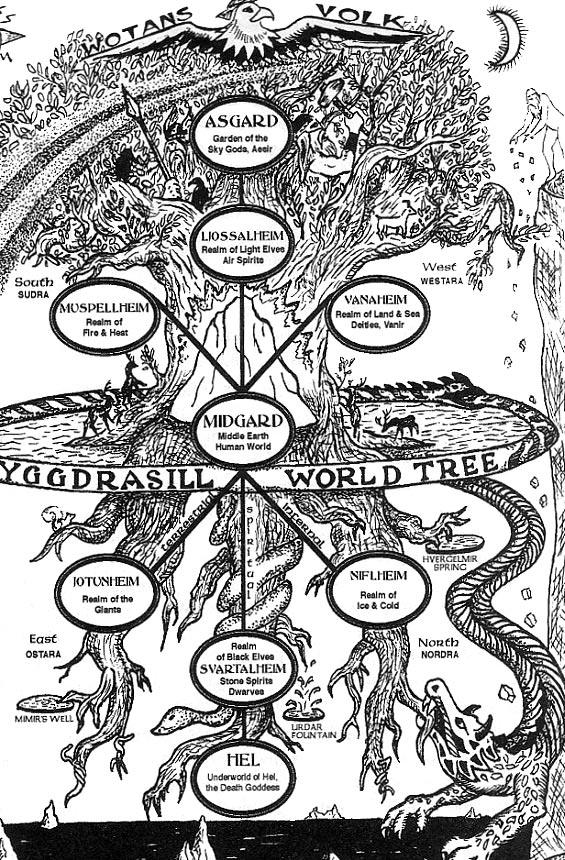 The tree on which Odin hung northern mythology is called Yggdrasil and symbolizes the Tree of Life. The Old Norse word "ygg", according to some writers, is another name for Odin, but, in my opinion, it is better to translate it as "I", which indicates the presence of the original Spirit within us. The word "drasil" means "steed" in the sense of a carrier or transporter. Therefore, “the horse of my “I” is the force that guides the original Spirit, the creative and creative principle, through life's wanderings and experience of multidimensional reality for the sake of cultivating the human and expanding its limits. Therefore, the Yggdrasil tree is also the Tree of Being of the Spirit, outside and inside time.
The tree on which Odin hung northern mythology is called Yggdrasil and symbolizes the Tree of Life. The Old Norse word "ygg", according to some writers, is another name for Odin, but, in my opinion, it is better to translate it as "I", which indicates the presence of the original Spirit within us. The word "drasil" means "steed" in the sense of a carrier or transporter. Therefore, “the horse of my “I” is the force that guides the original Spirit, the creative and creative principle, through life's wanderings and experience of multidimensional reality for the sake of cultivating the human and expanding its limits. Therefore, the Yggdrasil tree is also the Tree of Being of the Spirit, outside and inside time.
Before telling how the runes were revealed to Odin, and what he experienced looking into the depths of the Subconscious, it should be noted that the shaman northern tradition was also known as the "staff-bearer" or "rule-bearer". The staff can be compared to a magic wand.
There are two various ways work with runes - either for their own benefit and the achievement of power, even at the expense of others, or for the sake of personal development in harmony and balance with the forces of nature. Since each shaman had his own rune skills, the difference was often only seen in the results of their work - for the good or for the evil of themselves and others.
The term runic shaman
The use of the term "rune shaman" is only intended to refer to those people who worked with runes in their natural sequence, detailed below, and not in the "traditional" Futhark order adopted among rune sorcerers.
Runic shamans regarded runes as a divine gift, not simply because they were revealed to Odin in an unusual way, but also because, like any form of writing, runes served as a means of transmitting knowledge and wisdom. The runes were considered a blessing to mankind, given in a spirit of love and meant to understand the forces at work in nature and in human beings.
How Runes Formed
The nine runic sticks that belonged to the shaman reminded him of the Cosmic Law of Creation, whereby matter emerges from invisible energy and eventually returns to it. From Zero, from the abyss of Nothingness (Ginnungagap in northern mythology), everything that exists came into existence. From great mystery Nothing appeared singular Unity - Unit, containing in itself the dynamic dualism of opposites. At the merging of the Two, the Third arose, which set in motion the structure of infinite probabilities. Nine is the sum of three triples, denoting the primary cosmic scheme of being and the sequence of processes occurring in nature and in the Universe. Their combination creates integrity. Nine wands of the runic charter represented for the shaman the entire Cosmos - the totality of being - structured in nine worlds or "branches" of reality, in which the perception of life processes is possible.
Ready to sacrifice his "ego" for the purposes of the Soul and the ultimate good of mankind, shaman Odin took nine sticks and threw them to the ground as he hung upside down from a tree. The sticks formed a pattern of vertical and diagonal lines, from which, one after the other, angular symbols began to appear, a total of 24. Thus, the runes were revealed to Odin.
Sequential arrangement of runes
These 24 characters later became known as the "traditional" or "elder" Futhark runes, due to the F-U-Th-A-R-K phonetic combination of the first six characters appearing in the earliest manuscripts, oral rune poems and tales. This is the prototype from which all other runic systems originated. However, it should be taken into account that the sequential order of the runes given in the Eddas does not necessarily have the same order in which they were revealed to Odin. To make information accessible only to a select few and to hide its true meaning from the rest, it was customary to use allegories, symbols, or methods of permutation; at the same time, the meaning of the message became unclear to those who were considered unprepared or even unworthy to perceive it. However, the very number of runic symbols - 24 - contains several important principles of shamanism.
Harmony number 24
The number 24 is in agreement with the Cosmic Law of Harmony. It consists of three octaves, or eights, like musical notes. These runic octaves correspond to the movement in the vertical and horizontal plane of the higher, middle and lower levels, as well as the outer, central and inner. They are based on three main aspects of being: physical, mental and spiritual. The number 24 can also be represented as two groups of 12. Twelve is the number of stability and organization at the organic level, while the Two represents the duality of the active and receptive principles, complementing each other in the dynamic unity of the Cosmos.
In addition, the 24 runes can be represented as four dice, each containing three pairs of complementary opposites. Four symbolizes harmonic balance, and Three - creativity and change resulting from the merging of the feminine and masculine principles, One and Two.
According to Professor Sven BF Jansson, a leading Swedish runologist, these 24 symbols were used by all the Teutonic peoples and tribes of Northern Europe. His book Shamanic Runes states that of the 3,500 inscriptions on stones and other artifacts found in modern Sweden, the vast majority belong to this archaic system.
Professor Jansson and other research historians have concluded that in most cases the runes were not used for the sinister purposes of magic and sorcery, although sorcerous intent may explain why the meaning of some of the inscriptions remains unclear. By this I mean that, although the runes were used by people who sought power over the invisible forces of nature, they were opened to mankind for completely different purposes.
Rune use
Presence in Sweden a large number runestones and artifacts indicates that runes were widely used in Everyday life with good intentions: to improve well-being, to protect against diseases and the elements, to bring people into harmony with nature and with themselves.
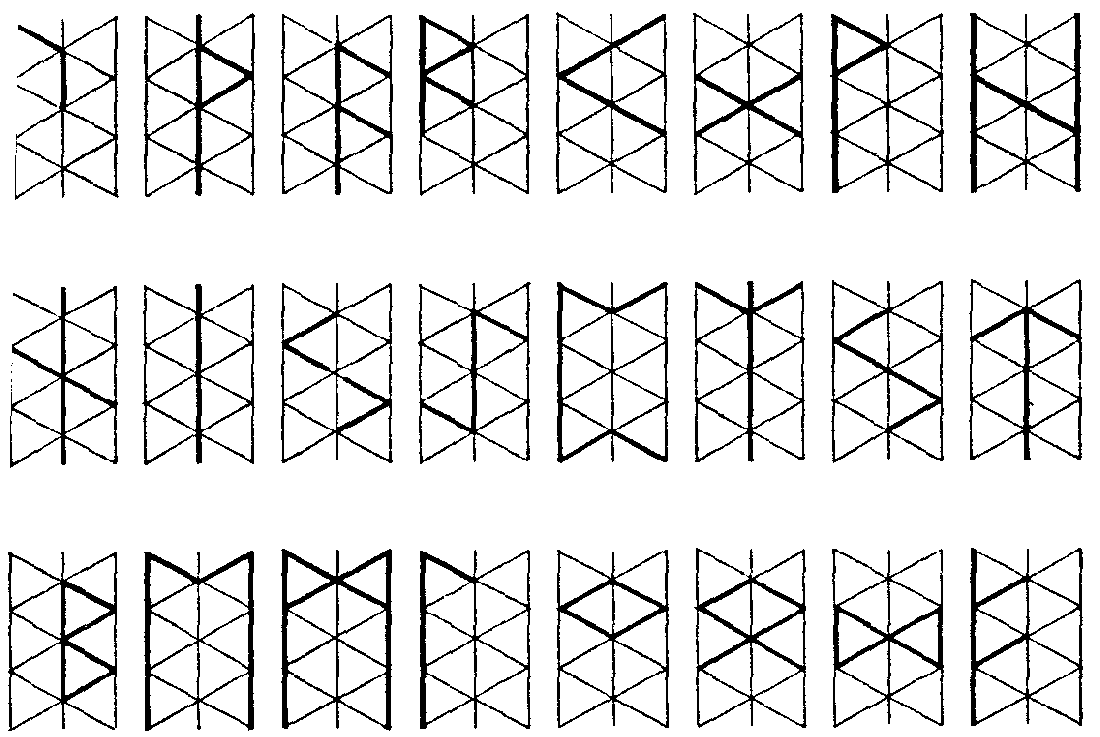
Like all natural powers, runic power can be used for good or for evil. For example, fire can be used to heat a house or cook food, but it can also set fire to anything that can burn. Nuclear energy can be used to run powerful factories and light up large cities, but as a weapon, it can bring death to millions of people and devastate the Earth. The end result is determined by the intention of the one who sets the force in motion and gives it direction. The same is true for runes.
What is a rune?
The truth is that runes are not inherently magical symbols or secret ciphers. Each rune is a receptacle of the transcendental potential, originally inherent in nature and in ourselves, which determines the qualities and characteristics of the forces that act on the physical plane and outside. Being qualities of the Soul, the runes express what is entering our human experience, affecting our lives now, or is in the process of change and transformation.
What were the runes on?
Since runes are made up of only two simple components - vertical and diagonal lines, they are easy to draw, cut with a knife or burn on wood, apply to skin, engrave on stone and metal. Runic symbols were applied to rings, bracelets, belts and personal items; on shields, swords, daggers and other weapons; for staves and shamanic tools, for amulets and talismans. Large boulders inscribed with runes, which served as memorials and landmarks, were especially popular in Scandinavia. Runic patterns were also used in the arrangement of facing beams on the facades of houses, which became feature german architecture. They were included in trademarks, monograms, and even in heraldic accessories - coats of arms and banners. In other words, runes played a significant role in everyday life.
Rune slander
In times of religious persecution, in the Middle Ages and later, the runes were slandered along with the old pagan beliefs. Those who used them were accused of heresy. Attempts were made to destroy the doctrine of the runes and to exterminate everyone who had anything to do with them. The knowledge hidden in the runes threatened the dogmatism of the "new" religion, which sought to convert everyone to its faith. Masters, writers, sorcerers and shamans who used runes were subjected to severe persecution. Within a few generations, the knowledge of the runes was almost blotted out of human memory.
What gives the use of Runes?
Runic practice inevitably deepens all visions and makes understanding and perception multidimensional and multicolored. The energy of all life becomes special, mysterious and magically charming. Existence acquires additional dimensions, new overtones of the music of life appear. In fact, the Runes unite the practitioner over space and time with legendary world ancient - forefathers. Everyday life more and more begins to resemble the magical spaces described in fantasy literature. However, it must be remembered that the result of the application of the Runes significantly depends on the sense of proportion and sanity of the one who decided to use this magic tool, which we inherited from the patriarchs of the northern civilization.
The runes are too powerful to allow a person to handle them frivolously and irresponsibly. Runes can accompany a practitioner to any of the upper and lower worlds of the universe, but they may well send a careless and licentious to a clinic for the mentally ill. Thus, the result of the application of the Runes depends almost entirely on the moral maturity and spiritual responsibility of the one who turned to them for help.
Fundamental postulate of Rune Philosophy
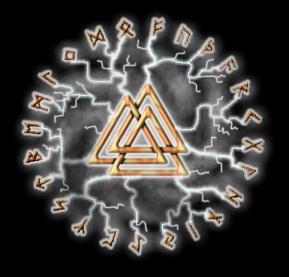 24 runes of the Elder Futhark can describe any process, any thing, as a sequence of semantic concepts, as a sequence of Runes. The great mission of the god Odin is that he gave people a certain number of certain concepts. These are the bricks of the universe, the details of the world constructor. And none of these bricks is superfluous. And all the bricks together give a whole, complete picture that does not require additional elements.
24 runes of the Elder Futhark can describe any process, any thing, as a sequence of semantic concepts, as a sequence of Runes. The great mission of the god Odin is that he gave people a certain number of certain concepts. These are the bricks of the universe, the details of the world constructor. And none of these bricks is superfluous. And all the bricks together give a whole, complete picture that does not require additional elements.
All concepts were defined many centuries ago. A lot of time has passed, but they are ideal for all modern situations and processes. Although, why be surprised! What are several centuries and even several tens of centuries for the universe… An instant.
Each of the concepts should be displayed in short form, as a symbol. And so Odin gives us the symbolism of concepts. Runes-symbols appear. Interestingly, the human body is able to display each runic symbol. And isn't the Gymnastics of the Runes, consisting of poses that display one or another rune, the oldest way of addressing a person, both to another person and to the gods? We can talk about a system so ancient that it existed even when there was not only no written language, but even no spoken language! Isn't this system a system of commands transmitted from gods to people, a system of controlling people with the help of command-concepts, expressed in a short form with the help of runes? When the need for writing arose, the rune system formed the basis of the alphabet. We perceive the runic system as a system of global concepts expressed in a concise form with the help of symbols.
If we create a runic symbol, following a certain technology and a certain ritual, then we are already using runes as magical elements. We not only communicate information in the form of a global concept, or a list of concepts, but we are already launching a mechanism for influencing existing reality according to the given concepts. We create magic!
One threw nine sticks on the ground. The sticks formed a matrix of vertical and diagonal lines. By selecting certain segments of the matrix, 24 symbols appeared - Runes. The sticks fell to the ground and formed a matrix, a matrix of runes. It is quite possible that, considering this or that concept, Odin took a pose corresponding to this concept. Perhaps a certain posture contributed to a fuller sense of a certain concept. Then, in order to depict the pose in the form of a symbol, he threw the sticks on the ground, making up a symbol from them. The symbol repeated the outlines of the pose, and became a reflection of a certain concept. The original nine sticks are the whole Cosmos - the cosmic tree. It represents nine worlds. This is typical both for the whole universe and for the micro - universe - man. The most accurate and accessible description of the nine worlds and the cosmic tree itself was given by the famous rune researcher Kenneth Meadows in his book "Rune Magic".
Cosmic Tree of nine "worlds" with Earth reality in the center ( northern tradition)
Kenneth Meadows "Rune Magic"
In the cosmic Tree there are nine "worlds", or nine planes of being, where toEach of the worlds is isolated from the others and functions differently, its existence makes an important contribution to the well-being and harmony of all things. This is true of the entire universe, and since each person is a miniature universe, we are built in a similar way.
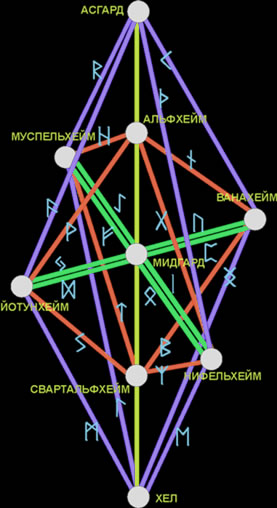
Midgard, key rune YARA
Let's start with the Middle World, whose name Midgard literally means "Middle Earth". It is called so because it is located in the center of the cosmic structure, at the point of interaction of all other worlds. Here, all aspects of our integral being - physical, energetic, mental and spiritual - are in dynamic balance, influencing each other. This is the realm of everyday reality, reason and emotions.
Here where Time rules, and the temporary "I" dwells human personality . Here, in equal amounts there are forces that we call Good and Evil, and every act is the result of choice or tacit consent.
Midgard - the habitat of mankind, "home in the midst of all things."
The key rune of Midgard is YARA closely related to the earth element. Its main property is the "rotation" of time, since this force controls the change of seasons. It is expressed in gradual changes and development, clearly pointing to the true purpose of our earthly life: this is a period for the development of all aspects of our integral being for the sake of the perfection of the Spirit.
Alfheim, SOL key rune
Above Midgard on the vertical axis is Lightalfheim, which in short is usually called
Alfheim - that is, the place of enlightenment, where the light of reason reigns. This is the realm of the intellect and imagination. This is our mental Universe, and we are well acquainted with it, without even suspecting its existence in an alternative reality.
In northern myths Alfheim served as the abode of elves- tiny creatures that rarely caught the eye of people, but had a strong (beneficial, but more often insidious) effect on the human mind. The reason for this is that they are collective thoughtforms that are not really easy to "see".
The key rune of Alfheim is SOL - the potential of solar energy, allowing you to perceive the hidden. This rune is usually associated with the rising sun and with the element of Fire, although in northern mythology the solar deity also had a feminine aspect. This aspect represented not the sunshine of the day, but the reflected light of the night moon. Alfheim is the realm of the Mind, but the Mind itself is only an emanation of the Soul and reflects its light. The rune SOL, although associated with the movement of the Sun and the Soul, is associated here with the Mind, as with a reflection of the Soul.
Svartalfheim, YO Keystone Rune
Under Midgard on the vertical axis is located
Svartalfheim meaning "kingdom of the gnomes". In northern mythology, the gnomes are a kind of counterpart of the elves, but they are creators. They process the raw material of the earth's interior (for example, gems), giving it a complete shape. In classic Disney cartoon"Snow White and the Seven Dwarfs" dwarfs are shown as miners engaged in mining precious stones. Mythological gnomes, personify creativity of the Lower World: these are processors and shapers of everything that comes into being in Midgard. Thus,
Svartalfheim is realm of "becoming" where the future is formed from mental images of the present; it is associated with subconscious activity that takes place below the surface of consciousness and maintains the structure of our "ordinary" reality.
The key rune of Svartalfheim is YO, whose statutory mark symbolizes the spinal column, tree trunk or plant stem: the central axis that supports the physical body. Therefore, Svartalfheim represents the level of consciousness corresponding to the subconscious aspect of Mind, the servant of the conscious self.
Hel, key rune HAGAL
At the very base of the vertical axis of the Yggdrasil tree is Hel. However, this is not hell in the Christian sense, as the name might suggest. The Christian underworld is an interpretation of the Jewish Gehenna: a public dump in ancient Israel where waste and dead plants were burned. According to the ideas of our northern ancestors, Khel served as the abode of the dead. In the natural cycle, life leads to death, and death leads to new life or rebirth. Hel was never depicted as a "fiery Gehenna". Fire for the ancient northern peoples had a completely different meaning than for the inhabitants of hotter countries located closer to the equator. In the north, the threat of death for a person was brought with it by cold, not heat!
The word "hel" means "sheath". Hel really "envelops" the natural forces that function at the deepest levels of the Unconscious.
This is the realm of stillness and inertia, a resting place associated with death. This is the abode of impulses and instincts, where the essence of the physical body is located - the bodily "I".
In pre-Christian northern religion, Hel had a dual nature. His personification was the goddess Hela, who, on the one hand, was depicted as a corpse, and on the other, as a beautiful, desirable woman. Thus, one aspect of the deity indicated the entrance to the tomb, and the other to the entrance to the female womb. The dual nature of the goddess implies that everything "dead" is reborn in the next cycle of being.
The key rune of Hela is HAGAL, a transforming power contained in the seed of living beings. It is the power of becoming in an inert state. It is like a bridge that allows you to cross from one side to the other.
Asgard, key GIFU rune
At the top of the vertical axis of the Cosmic Tree is Asgard, the celestial the realm of the "gods" or "shining entities". Although Asgard is located in highest point The tree, almost out of reach, is actually the most intimate part of the human being.
In the views of the shamans of Central America, there is a similarity with the views of their northern "colleagues": they believed that all living beings have a Spirit that lives both in spiritual reality ("nagual") and in physical reality ("tonal"). According to their concepts, after death and renunciation of the flesh, awareness continues to exist in the spiritual reality, where it is surrounded by energy fields created within the human being during his earthly life. Therefore, we create our own hell!
The supreme position of Asgard meant that this place could only be reached after determined, persistent efforts and (in the shamanic tradition) with the help of Valkyries. The mythological Valkyries were the daughters of Odin, who accompanied the souls of the dead Viking heroes in kingdom of happiness eternal life . The word "valkyrie" means "one who chooses among the dead." Valkyries symbolize the perfection of the human "I", which, valiantly fighting in earthly life, deserved a happy afterlife for itself. Key rune of Asgard - GIFU
In the horizontal plane there are four "outer" worlds.
Nifelheim, ISS key rune
Nifelheim (the name means "abode of fogs") - a place of illusions, where the external forms are in accordance with the internal essence of the observer. It has a magnetic force that draws things into itself, like a "black hole" in the universe.
It was claimed that water is "born" in Nifelheim. Mist is water in a vapor state, and water has the ability to solidify as ice, so it refers to a state between tangible and intangible. The key rune of Nifelheim is ISS.
Muspelheim, key rune DAGAZ
Muspelheim (the name means "abode of fire" or "realm of passion") is the opposite of Nifelheim, mutually complementing it. This place is like electrical energy, constantly expanding from its source. Mythical creatures associated with this kingdom were called thurses. They were of great age and owned both transformative and destructive force. The key rune of Muspelheim is DAGAZ - the power of transfiguration and transformation.
Vanaheim, key rune ING
Vanaheim is the home of the Vanir. The Vanir are intelligent forces that govern organic processes and natural abundance, which is why Vanaheim was sometimes called " a place of peace and abundance". Its key rune is ING, the energy of conception and organic growth.
Jotunheim, NIID keystone
Jotunheim is home of the giants endowed with gigantic dimensions and great power. This realm of intellect and imagination; both of them are terrifyingly powerful. The key rune of Jotunheim is NIID, which is associated with the necessary changes.
Bridges between worlds
Existing outside of us, these nine "worlds" also form our inner Universe. Cosmos - the integrity of collective and individual being - includes the inside and the outside, the known and the unknown.
According to the teachings of some mystics, the nine "worlds" are connected by twenty-four "lintels" or "bridges" holding the Cosmos as an indivisible whole. Each of the worlds is controlled by an irreversible rune that protects the entrance, like a door or gate, and at the same time opens access to another level.
An irreversible rune looks the same in normal and inverted form.
There are nine such runes:
GIFU, ISS, HAGAL, NIID, YARA, SOL, YO, ING and DAGAZ
Inner conductor
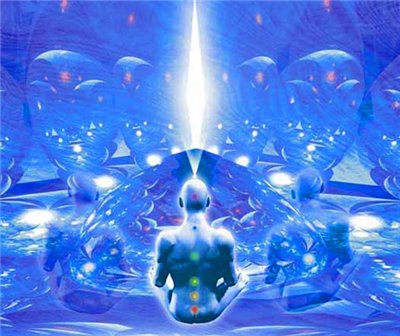 The 24 bridges between the worlds are explored through a method called "shamanic dreaming". It is similar to the methods used by the Kabbalists and those involved in the study of the deep esoteric aspects of the Tarot book. Shamanic dreaming cannot be carried out without an inner guide. This is not a spiritual leader, not a guru, and not an external force, like spirit guides at séances. The inner conductor is on the inner levels of being. This is the entity that guides and protects the physical body during its incarnation; it exists in the form of energy and has intelligence.
The 24 bridges between the worlds are explored through a method called "shamanic dreaming". It is similar to the methods used by the Kabbalists and those involved in the study of the deep esoteric aspects of the Tarot book. Shamanic dreaming cannot be carried out without an inner guide. This is not a spiritual leader, not a guru, and not an external force, like spirit guides at séances. The inner conductor is on the inner levels of being. This is the entity that guides and protects the physical body during its incarnation; it exists in the form of energy and has intelligence.
You cannot find the inner guide simply by calling on it, because it is already with you. You must allow it to reveal itself to you, and this can only be achieved through the intention expressed in the shamanic journey - an altered state of awareness in which more high levels our multidimensional existence. The inner guide takes care of you: it is a friend, companion, adviser and protector who rejoices at your achievements in the process. spiritual development.
24 transitions in the structure of the Cosmic Tree Yggdrasil
The nine realms are also the levels of awareness experienced by runic shamans during their "journey" with the runes. A shamanic journey is a movement into another reality, usually with the help of a shamanic tambourine or rattle. This is a deliberate act of shifting awareness to another area of multidimensional being in order to perform a specific task, solve a particular problem, or gain knowledge. During the journey, the shaman plunges into a dream-like state, perceiving the properties and attributes of the rune as visual images, sounds, feelings, and even physical sensations. Such journeys can be as vivid and "real" as in everyday life.
Roots of the Yggdrasil tree
According to legend, the roots of the Yggdrasil tree, though firmly rooted in the soil of reality, go deeper, receiving water from the subterranean or "unconscious" levels.
First root
The first of the three roots is immersed in the Mimir spring (the name means "memory"). But this is not a simple demand for information contained in the human mind and related to our mortal self. Rather, it is the knowledge of the Soul, where the memories of life before our birth are stored. In order to drink from this source, Odin sacrificed his "eye of reason", associated with the mind. He strengthened the intuitive vision associated with the Soul, and thus was able to "see" inaccessible to the intellect. The memories received from the Mimir source are information about the potential talents inherent in our holistic energy system. They have manifested in previous incarnations, and now they can be revived for use and development.
The waters rising from the root of the Yggdrasil tree symbolize the introduction of the unconscious into conscious experience. The branches of its immense crown symbolized the realm of Reason and thoughts, which move like air and are also intangible. The top of the tree reached the heavens, symbolizing the path to the realm of even more subtle energies of the Soul and Spirit, access to which is opened through a vertical pillar connecting the Upper and the Lower.
In northern mythology, Mimir was also called the wisest of the ethins, who gained knowledge by drinking water from a sacred spring. The waters of Mimir's knowledge are the ancestral memory of our ancestors and memories from past lives, each of which influenced the next. Each separate life can be considered as a stage in the process of perfection of one immortal Spirit. Like pearls in a pearl necklace, the line of life continues in the Spirit.
Second root
The second root of the Yggdrasil tree took water from the well of Urd, where, according to myth, three Norns lived, spinning the thread of Wyrd. Although the word "wurd" is most often translated as "fate", it does not mean something predetermined. It is not identical with the concept of karma, which states that certain privileges or trials in current life are a reward or punishment for deeds done in past life. The Norns represent the natural process by which the energy of our individual actions is distributed, transformed, and returned to its original source. In other words, each of us decides our own destiny with our thoughts and actions.
third root
The third root of the Cosmic Tree descended into the bottomless pool of Hvergelmir, where it was tirelessly gnawed by a huge dragon, personifying the endless process of absorbing the past by the present and transforming the present into the future.
The water coming from the roots nourishes the trunk and branches of the tree down to the smallest leaves. It then soaks into the soil and returns to the source for a new cycle of activity. Thus, each of us has a personal wurd: the integrity of the experience of our past lives and the conscious actions taken in the present life. Each of us weaves the web of our destiny.
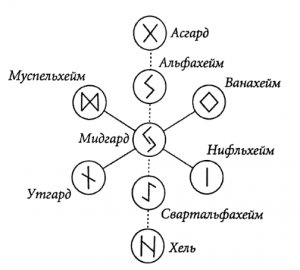 Each of the nine worlds has its own key, irreversible rune. An irreversible rune looks the same in its normal and inverted positions. Worlds - nine, irreversible runes - nine.
Each of the nine worlds has its own key, irreversible rune. An irreversible rune looks the same in its normal and inverted positions. Worlds - nine, irreversible runes - nine.
The nine worlds are connected by 24 "lintels" or "bridges" holding the Cosmos as a whole.
Rather, 9 worlds are connected by 20 jumpers, four vertical jumpers are the trunk of the Tree. Four horizontal jumpers are controlled by two runes. In fact, each horizontal jumper consists of two parts. Why are they displayed with two lines. Each part is controlled by its own rune. The remaining jumpers consist of one part and are controlled by one rune.
Runes of the Magi
Having done a colossal work, Yuri Larichev found a connection between the letters of the alphabet, the Futhark runes with the arcana of the Tarot and the tree of life (Sephiroth).
The runes reveal the forgotten knowledge of our ancestors and allow us to comprehend the bright path of the Magi. In his books, he reveals the significance of the origins of the Russian language as a sacred one, allowing one to think with absolute purity, being a mirror human soul and a ray to the light of knowledge. You can burn all the manuscripts, get rid of the magicians, but it is not possible to erase the information that is in every person. Look at the root, become pure in spirit and you will find everything you are looking for in yourself.

Roman - arcana.
Green - alphabet letters
To the right of the runes - the numerical value of the runes, letters of the alphabet and Hebrew.
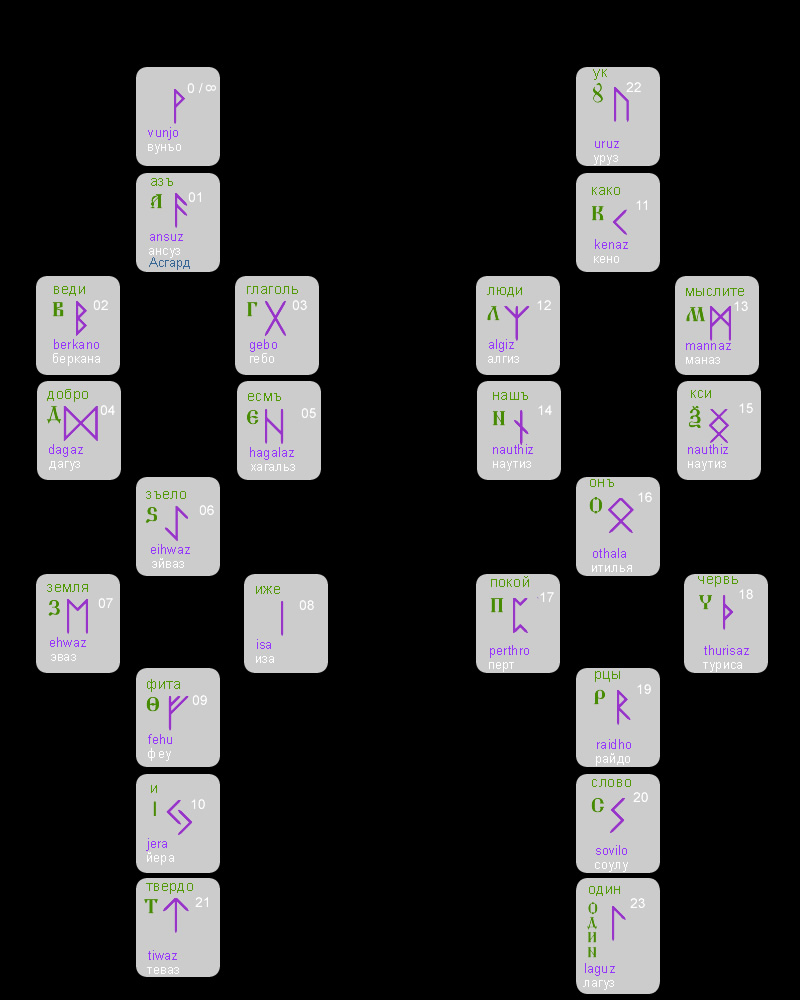 The arcana of the Tarot, as the oldest scripture, known as the "Holy Book of Thoth", is a set of philosophical doctrines, the harmonious connection of which allows us to plunge into the science of knowledge, both of ourselves and of the entire universe. The meaning of the arcana is very well revealed in the fundamental work of V. Shmakov “The Holy Book of Thoth. Great Arcana Tarot. The Absolute Principles of the Synthetic Philosophy of Esotericism. Moscow. 1916. The book is reprinted ed. "Sofia" (Kyiv) in 1993
The arcana of the Tarot, as the oldest scripture, known as the "Holy Book of Thoth", is a set of philosophical doctrines, the harmonious connection of which allows us to plunge into the science of knowledge, both of ourselves and of the entire universe. The meaning of the arcana is very well revealed in the fundamental work of V. Shmakov “The Holy Book of Thoth. Great Arcana Tarot. The Absolute Principles of the Synthetic Philosophy of Esotericism. Moscow. 1916. The book is reprinted ed. "Sofia" (Kyiv) in 1993
Man is the universe in miniature
The system of worlds can be applied to humans as well.
Vanaheim (earth element) - the physical body.
Nifelheim (ice element)- ethereal body. Energy body. An ethereal counterpart that almost coincides with the physical body. After the death of the physical body, the etheric double is discarded and a slow disintegration begins. The ethereal sheath remains a few meters from the decaying physical body, and because it is easily visible even to those who are even a little sensitive, it is the cause of many walking stories about graveyard ghosts. Mentally developed person passing through one of our great cemeteries, one may observe a multitude of these bluish-white, hazy forms hanging over the graves where the physical shells they have recently left lie.
Muspelheim (fire element)- astral body. Every physical object has its astral counterpart.
Jotunheim (intellect) is the mental body. The mental body consists of even finer degrees of matter belonging to those levels of the mental plane that still have form.
Alfheim (soul) - Causal (causal) body. Guide of the Higher Self, demonstrating the stage of development of the true Ego on its way from birth to birth.
Svartalfheim - subconscious.
Midgard is the assemblage point. Here everything is harmoniously combined. When they say about a person that he passes from one of these worlds to another, they mean not only his movement in space, but a change in consciousness.
When we focus on the mind, we shift the assemblage point to Jotunheim.
Working with the subconscious, we shift the assemblage point to Svartalfheim.
By establishing a connection with the soul, we shift the assemblage point to Alfheim.
With excessive earthiness (the power of instincts), we shift the assemblage point to Vanaheim.
With increased energy, the assemblage point shifts to Muspelheim.
At rest, the assemblage point shifts to Nifelheim.
Astral travel is a journey through the Nifelheim system of worlds.
Every man contains within himself the matter belonging to each of these planes, and has for each of them a corresponding vehicle or body. Each of these bodies responds only to the vibrations of its own world. For example, while the consciousness of a person is concentrated in astral body, he will perceive only the astral world. Our consciousness, using only physical senses, feels only the physical world, although these worlds, as well as many others, surround us all the time.
And a certain civilization (or a part of this civilization) can simply abandon Vanahem and exist in all other worlds. They will be, but we simply will not see them, because we are focused on the physical world, on Vanaheim and fixated on it. And as long as an ordinary human civilization does not affect the interests of a more developed civilization in the subtle worlds (without realizing it at all), then there is no conflict of interest. IN otherwise there is a conflict of interest. And here it is obvious that a more developed civilization, having the ability to explicitly operate on a subtle plane (for example, energy and astral), can very easily change the existing physical reality.
And if we move away from such global concepts and turn to the level of a person through projection, then we will see that a highly developed person who has the ability to operate on subtle planes is able to change the existing physical reality through these subtle planes. Here it is - the mechanism of psi-reality.
ego like driving force consciousness prevents us from building our inner world. For the Ego aims at transformations in physical reality.
Jotunheim (consciousness) "organizes" matter. All changes in matter are described by the laws formulated by Jotunheim. Let's take an example. All the diversity, functionality and beauty of nature would not be possible without natural selection ruled by Jotunheim. As a result, Jotunheim and Vanaheim cannot exist without each other. There is one more point. Jotunheim needs "recharge" from Jotunheims of biological beings, and first of all people, each of which has its own Jotunheim. The activity and functioning of biological beings in the material world is determined by Jotunheim and Vanaheim. The material world, displayed only by Vanaheim, without Jotunheim, will be devoid of development. You can even say more - he will be deprived of the initial idea of \u200b\u200bcreation. And the material world, displayed only by Jotunheim without Vanaheim, will be insane. But just above it was said that a certain civilization can abandon Vanaheim and exist in all other worlds. Yes. But their world is not Vanaheim oriented. And we are talking about the world, about a civilization oriented towards physical matter, towards Vanaheim. On the whole, the Universe without Vanaheim is unthinkable.
If a person wants to create something where his Ego will realize what it did not realize in ordinary reality, then this will be an unhealthy mental process. This is madness. Here a fine line, which distinguishes between true inner peace and "woe from the mind." The ego will "push through" ideas that could not and cannot be realized in ordinary reality. And no matter how much you build your inner world, following these positions, you will not achieve happiness. The ego will build a world full of unhappiness. After all, it is not realized in the physical world, which means that it does not fulfill the goals of the Ego - to realize what was conceived in the physical world. This means that the world created with the help of the Ego is obviously not happy.
So we cannot rely on a consciousness that is controlled by the ego. In addition, you must understand that, operating with the concepts and principles of consciousness, we operate with general things to our personality, which have nothing to do with our inner essence. We will build not our inner world, but we will build something public. Public doesn't mean bad. It just won't reflect our inner essence again. We will leave something, and we will find ourselves among what we left. We need to interact with something that will reflect exactly our essence. Therefore, we must carry out a dialogue with our higher "I", as with the most developed aspect of your personality. Alfheim. A special dimension, the dimension of the soul. The Higher Self has the experience of many lifetimes and naturally has higher wisdom compared to ego. The Higher Self is silent and does not interfere with the plans of the Ego, even if these plans are obviously wrong. It does not speak unless asked, but it does not refuse to answer when asked. It reflects our true identity. If you create your own, inner world, receiving information from the higher "I", then this will be a world of true happiness. And this world can then be realized in the real world!
It would seem there is some paradox. The individual may die, but the higher "I" knows everything and is silent. This is just so at first glance. The Higher Self speaks. It speaks, but we just don't understand its language. We understand the language of our ego well. By and large, we have become Ego. We have shifted the assemblage point to Jotunheim. And let the Ego run it. The ego speaks to itself. The dialogue turned into a monologue. But we don't notice it. We are like a traveler who walks ahead and talks to someone who walks behind. He walked and did not notice that there was no one behind him for a long time. The traveler is talking to himself. The traveler sensed this and looked back. You never have to look back. The demons of the past can eat us. There was neither yesterday nor tomorrow. The traveler is blind and deaf. He is still wandering and looking for the one who followed him. This little oriental allegory illustrates the situation very well.
Ego is only the driving force of consciousness. Ego is a pure movement, and consciousness is a movement of understanding, development. No development, no movement. No movement, no consciousness. The ego doesn't want to lose. It will always seek to hide defeat, and even if there is no development, the Ego invents a false development. The horse rushes, biting the bit, the locomotive sways, imitating movement. And with all this, - Ego is not me, not he, not she, not you. Ego. Movement. And nothing more. No one points to a burning fire, and does not say - it's me. But there, too, a fire is burning, - and that's me. Likewise with Ego.
But it's still half the trouble. Let us turn again to the above allegory. Demons of the past. Here is the second half of the trouble. The past teaches us. We live one life, another, we go through certain milestones in the current life. The ego operates only in the current life. The ego is only meant to move forward. But it is not called upon to evaluate the movement, nor to draw conclusions and direct development in accordance with the conclusions drawn. In the current life, this is done by the consciousness, and for the entire time of our incarnations, this is done by the higher "I". The Higher Self knows everything that has happened to us throughout our lives. It knows what our destiny is and what we need to do in the current life. He has true information, in contrast to the consciousness that sees only the situation in the current life and, moreover, is often in an oppressed Ego state. So, the demons of the past. This is one side of the issue, and the Ego is the other side. And we instruct the Ego to deal with them. We are trying to observe the invisible side of the Moon through a telescope. The ego cannot do it. The demons are eating us. Phobias, diseases, mental illness. If we build our inner world with the help of the Ego, we will build this world for the demons of the past. They will come in there and give us a real hell. For the higher "I" - demons something. These are only millstones for making the best flour, these are just rollers for making a perfect product. For the higher "I", the demons are only servants, but for the Ego they are masters. They force the ego to run forward. Building our inner world, we try to neutralize the demons in order to get a break. We need a new movement. Movement from movement. This is peace. The ego cannot stop, but we can. We can withdraw for a while into our inner world, because we need to stop. The time will come when we will go forward again, but now we cannot go. Everything needs to be rethought. You need to wait for the wave, saddle it and boldly ride it into the distance.
We have dealt with Ego. Higher "I". We settled on the fact that we do not understand his language. It speaks, but we do not understand. But in your inner magical world, we will be able to understand what the higher "I" tells us. The higher "I" speaks the language of symbols, images. Images that reflect global concepts. If we build our inner world on this foundation, we will create opportunities for the higher self to speak to them. But we cannot speak directly to the higher self. To do this, we must be filled with the light of the soul. Then we will merge with the higher "I". This is Nirvana. Now we will not consider processes that are available to very, very few. We consider processes available to any person. We look at our inner world. So, we cannot communicate directly with the higher self. We need an intermediary. The subconscious mind is such an intermediary. It is also called the hidden "I".
Yes, yes, you say. We have been taught all our lives that the subconscious mind does not only perform good functions. The hidden subconscious self is almost incapable of reasoning, but has a good memory and learns skills through commands and repetition. This is a great blessing - to unload consciousness from routine matters. But the subconscious also absorbs the negative. It is in the subconscious that the roots of all diseases, phobias and problems are hidden. Everything that cannot be resolved, everything that was once negative, all this sits in our subconscious. And at any moment it can be "splashed out" into our inner world, instantly filling it with negativity. We open the way for demons to our inner world. We are creating hell. No. This is wrong. It was the Ego that turned everything upside down. It is the Ego that fears them. The subconscious mind simply stores information. Yes, this information is endowed with emotions. All the horror created by the demons is stored there. There is often stored such information that is so terrible that the consciousness simply cannot cope with all the fears. Such information is blocked. Otherwise, consciousness will not cope and the person will go crazy. But, for the subconscious itself, this information is not terrible. For him, it is neutral. Zero, one. binary code. The subconscious reacts violently, gives out the most powerful emotions because, this was taught to it by the Ego. The ego programmed him. Here is the demon. Here is the reaction to it. The subconscious obediently and trustingly performs. So, if we pull out such information from the subconscious, then the consciousness will suffer. For him, such information is "poisonous". And for the higher "I" this information simply reflects the conditions in which the individual found himself in order to cultivate certain qualities in him. The Higher Self is above all demons. If we build our inner world, receiving information from the higher "I" through the subconscious, then the demons that have fallen into it are just images completely dependent on you. And images that are obviously weaker than you. Roughly speaking, an unarmed person (consciousness driven by the Ego) collides with a bandit armed with a knife. One on one. Scary. Scary. But in his inner world you are not unarmed. You can use any weapon, up to a nuclear bomb. You can create such conditions for him... You are the master. And the judge, and the authority, and the law. All of you. This is one side of the issue. The other side of the issue is that in addition to images and emotions, your emotions on the image, emotions that may have been the cause of your phobia, there are also comments in the subconscious. These comments are given by the higher "I". What was the reason for the rigid framework in which you found yourself. What a way out. But this is the practical side of the issue. Purely practical. By deciphering the images, you can receive and fix priceless information in your mind. And further to get rid of phobias.
Working with runes in practice
Reunion with the Tree of Genesis
During the nine days and nights spent on the tree, Odin proved one important truth: before we "find" ourselves - to discover who we are and what we really are - we need to open ourselves to our higher self, the highest and most noble aspect of our whole being. It will, in turn, respond to us and open itself to the benefit of the lesser self.
Find a place where you can be quiet and alone for a while.
Take a pen and notebook with you. Stand facing north, in the direction of the North Star - the turning point around which the universe revolves. Connect your legs and raise your arms at a 45° angle to your body in the form of a Z-rune olgiz.
Focus on the connection with this rune. Through it, you can connect with the Tree of Genesis and expand the boundaries of your awareness. Keeping the initial position, say the following words aloud (they must be learned before completing the task):
Connecting with the Tree of Genesis,
I give myself to myself.
When I take the runes
I am driven by love and harmony.
May I be granted understanding
And those whose lives are connected with me
May they also be blessed.
Pause and try to understand the meaning of what was said. Then wait for a response. It can come through: 1) sensation; 2) mental image; 3) feeling - either in the form of a combination of all three points. When you get the answer, put your hands down, relax, take a few deep breaths, and write down how you feel.
Afterwards, think carefully about your experience and look for the understanding that comes from within. It may not come immediately, but later and unexpectedly, and this too should be recorded. I want you to keep a written record of your personal experience work with runes in a special Journal of Self-giving, in which you can freely express your experiences and innermost thoughts without worrying about how others will react to this.
Recordings will help you understand who you are, where you came from and where you are going in developing your "ethereal" perception. They will become an integral part of your runic quest - a journey that will lead you to know yourself.
Where you came from?
Having acquired a book to record your rune work, you can now open your Self-Sacrifice Journal. This magazine is more than Personal diary. This is a part of your Sacred Space that belongs only to you. It is a safe haven where you can discover your innermost thoughts without worrying about what other people think about it.
Your first entry describes your experience of reconnecting with the Tree of Genesis. It should be supplemented with a short account of the paths you have explored, of your searches and reflections - of every philosophical concept, every religion, sect or cult that has attracted your attention. Start in order - preferably in the order in which you gained experience. What brought you to this? What was the attraction of this or that idea? What doubts did you visit? What experiences have enriched you the most? What caused you the most pain? What are the main lessons you've learned from each path you've taken?
Don't try to complete the task in one go. It is better to move forward step by step for several days, carefully considering each point.
Self-esteem
The main purpose of understanding the runes is to continue our individual development and the cultivation of the Spirit. In preparation for working with runes, we first need to work on ourselves. It is very important to do this work before we have enough experience to give advice to others. There is a great shamanic truth in the saying that we need to take the log out of our own eye before helping to take the straw out of our neighbor's eye. Therefore, you have to do new record in your Surrender Journal.
First, make a list of everything you like about yourself. This positive traits, strengths your experience, activities that you enjoy. List them under the heading "My light list."
Then list everything that you don't like about yourself: your flaws, weaknesses and bad habits, activities that you don't like, lack of certain skills or qualities of character that you would like to have. List them under the heading "My Dark List". Be frank. Don't hide anything from yourself.
In the previous exercise, you reflected on where you came from and what brought you to where you are now. This exercise is about assessing your present. Make a "light list" of all your assets, both physical and mental. Then make a "dark list" of your unfulfilled obligations and everything that prevents you from becoming the person you would like to see yourself.
Now consider the Future. Make a "light list" of your hopes and aspirations. What kind of person would you like to become? What would you like to achieve in your life. Then make a "dark list" of things and events that you would rather avoid but are more likely to happen if you don't change your life.
And finally, when all four lists are ready, try to think them over carefully, noting the advantages that direct your life along the most desirable path, and the disadvantages that hinder your development. The result should be a clear definition of those conditions of your life that need to be changed so that you can come into harmony with the “bright” Future.
This task must be completed without haste. Don't try to complete it in one sitting. It is best to do it within a few days. Don't underestimate its importance. When you finish your work, you will have an important experience of self-esteem that will be useful in transforming and improving your life.
Collecting Runestones
While the rune set can be purchased from Way to Yourself stores, it's best if you assemble it yourself. This can be done during a country walk.
Choose a time for a walk in nature - in the forest, on the sea coast, in the countryside - and devote it to finding your stone "helpers". Shamans of all cultures and traditions, who had a deep affinity for the Earth, considered the mineral kingdom to be the most ancient, since it appeared on earth long before plants, animals, birds and people. The stones were considered the "bones of the earth" and, like a skeleton, formed a structure that held everything in place. Rocks are of great age, so they can be considered as wise helpers for people seeking communion with nature. Minerals (including crystals and gems) were considered to be receptacles of energy, since their energy vibrations are very slow, and are in an inert state. Therefore, stones are the most suitable material for a rune set: they firmly and invariably hold the energy vibrations of each rune.
Finding the 25 gems for your set - one for each rune plus the 25th stone of Destiny - should be done without too much haste. It's not just about mindlessly picking up whatever size rocks you see while walking - you have to let the rocks choose you! How to do it? Quite simply, by actively focusing your intent on it as you search. Say to yourself (or rather, instruct your subconscious self): "I went on this shamanic walk so that the stones needed for my rune set could show themselves." Somehow your attention will be drawn to certain places and the stones that are there. Look for small flat stones, about two centimeters in diameter.
When a stone catches your attention, pick it up or carefully remove it from the ground with a penknife. If its shape and size seem suitable to you, take it to right hand, close your eyes and ask yourself if this is the right stone for you. Then wait for an answer. If the stone suits you, you will experience a clear sensation or emotion - an intuitive inner confirmation. If there is no answer, return the stone to the place where you found it. Treat him with care and respect.
You may only get a positive answer on two or three occasions during your search, so you will likely need to take a few walks before you have a complete set. Every time you bring your stones home, wash them thoroughly and store them in a safe place, preferably on a windowsill where they can be lit. Once you have a complete set, you will be ready for the next stage of rune work.
Runes video
Answering this question “in a simple way” is not even an easy task at all. At the everyday level, this is a sign system related to the alphabetic alphabet. You can really make words out of them, but not all of them. Even the uninitiated feel in runic writing something deeper than a simple means of conveying linguistic information. The Scandinavian and Turkic runic traditions are the most well studied. Slavic runes and their meanings are less clear.
In the traditional interpretation, the true runes are represented only by the Senior ranks and their derivatives, this includes the Slavic rune ranks. The rune is a sacred symbol that reflects the connection of Man, the World and Divine energy in their indivisibility. Each embodies one of the laws of the universe, available for awareness.
All other signs and rows, similar in symbolism to the Elders or named so by their creators, are not. They don't have ancient tradition and consistency of the Elder runes (dividing the rows into attas, the layout order, the limit for magical practice character interpretation accuracy). And the main condition that determines the "Runes": their essence is not in the transmission of speech and not in writing, but in the designation of universal sacred knowledge.
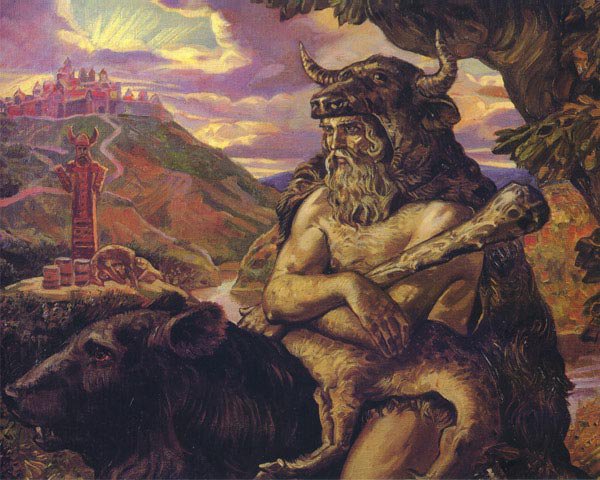
It is proved that in the territory inhabited by the Slavic-Aryan tribes, runic rows were used for writing, leading their history from the Elder runes. However, after the baptism of Rus' and the eradication of everything “pagan”, little information was preserved about them. Only the so-called Vendian series have been best studied. They are based on the traditions of the Elders, they have 18 runes, divided into three attas of 6 pieces each. The meanings of the ancient Slavic runes were used both in everyday circulation and for rituals and divination.
In the worldview of the Slavs, the runes reflect the trinity of divine power in everyday life. It consisted in the unity of opposites: Life - Death, Order - Chaos and Man - Warrior, making his way in the changing balance of these two forces. According to legend, the runes were given to the Slavs by the god Veles.
In the Vedic tradition, Veles has another sacred name - Ramna (he is also the god Raman in the Iranian-Aryan tradition, and Rama in Hinduism). In Sanskrit, the word "roman" is translated as "hair on the body." From here arise justified associations with the word "fleece" and "fleece", the relationship of which has been proven by linguists. That is, the word "rune" and "hair" form the name of the god Volos Ramna, from whom the Slavic Iarian tribes received the runes. It is Veles-Volos who is revered as the creator of runes.
Ancient Slavic runes - creating a set
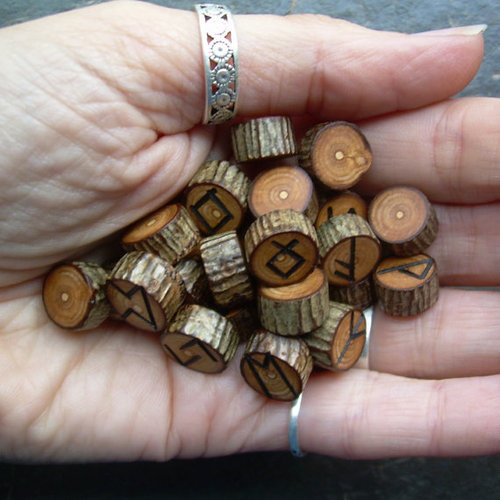
The set is usually made of wood or birch bark. Moreover, birch is best suited for all trees, strongly connected in spirit with the people of the Slavs. Taking a dry branch of the required thickness, make oblique cuts on it (as a sausage is cut). You will get a sufficient number of oblong dies. The wood must be smooth, dry and without flaws. Next, a sharp knife and an iron ruler are taken, with their help (with a firm hand) icons are cut out.
Rules for creating a rune set:
- The ideal production time is morning, dawn on the new moon;
- Call Veles, Mokosh and Yarila as witnesses so that they bestow magical power on the set. The request usually includes the granting of the energies of Strength, Might and Good. Offer gifts to the gods for their favor. Veles is a piece of meat that is fed to a dog, saying to himself: “Veles, father, as I feed a dog, I take Strength!”. Mokosh - colored beads and ribbons, it is best to tie them on a birch, near which a branch was taken for a set, singing: “Mokosh mother, as I tame a birch, so I gain Power!”. Yarile - mead (just mix honey with water), splashed towards the sun with a fan on a clear day, saying: “Yarilo is the luminary of my kind! As honey is shed, so the Good is acquired!”;
- Having cut out the runes, transgress to coloring. Symbols can be found in pictures and photos on the Internet. It is believed that one's own blood is the ideal paint for the rune, allowing you to create a stronger bond with the interpreter. It is not necessary to use such a dramatic method; ordinary stable paint or stain will suffice. You can make natural paint from egg yolk, thoroughly mixed with any bright red juice. Apply the composition with a thin brush and leave for a day;
- To activate ready-made blanks, like Rune, you need to appeal to the god Odin. To do this, take some beer and, lightly dipping your fingers into it, wipe the front of the rune. At the same time, say: “One, Father of the Runes, grant the Rune (the name of the Rune) strength and wisdom, connect the Rune (the name of the Rune) with Ash and Birch, Lerad and Urd!” (Lerad is the crown of Yggdrasil, Urd is a spring gushing from under its roots);
- Rune bag perfectly sew white color with the image of a gold or red rotisserie (the gyro is a right-handed swastika with six rays). The symbol was introduced into use by the Aryan tribes, and then it passed to the Slavs. The canvas for divination is decorated with the same pattern.
Ancient Slavic runes and their meanings
![]()
Slavic runes are junior runes, a sacred gift from the god Veles and ancestors. According to legend, they appeared simultaneously with the universe, as a reflection of its inviolable laws. The rune is a conductor in the intricacies of the laws of the universe. The interpretation of the rune series is a difficult job, here it is necessary not only to know the meaning of each rune, but also to understand its position in the layout.
The names of the ancient Slavic runes are listed below and their symbolic designations are explained:
- Rune Yes- the original Mother Goddess, the absolute embodiment of the feminine among the Slavs. Belongs to Zhiva - the keeper of life;
- Rune Ood- a symbol of God-husband, perfect male energy. It is represented as a god with deer horns and indefatigable sexual power. It was believed that the amulet with the image of Oud increases male power. She is patronized by Kupala;
- Rune Dazhdbog- the designation of the ancient ritual of fertilization by the Sky of the Earth, which was carried out by the Slavic-Aryan tribes to obtain good harvest. Corresponds to Dazhdbog - Slavic god agriculture, patron of fertility;
- Rune Chernobog- the incarnation of God-trickster, the ruler of the "other side" always hidden in the shadows, helping to discover deep, hidden forces in oneself;
- Rune Rainbow- a sacred bridge between the worlds, through which only the worthy can pass. She is patronized by the Rada, who gives the right advice and guides life's road goddess;
- Rune of Krada- the embodiment of the world Fire, as the need for spiritual development. Its meaning is opposed to the rune Is, which is responsible for physical needs. It symbolizes at the same time the sacred fire and the sacrifice brought to it;
- Rune Rock- The Power of Order, action within the rigid structure of the world, determined by the gods. Symbolizes Rock - a rare concept for the worldview of the Slavs. This is not the Roman Fatum, from which one cannot escape, but rather the great Laws of Nature, according to which it is necessary for man to live;
- Rune Need- following one's own law-order, which sees the goal and understands why a person needs self-restraints. Man is aware of the inevitability, but this knowledge is used for his own benefit;
- Rune Source- the gradual accumulation of power. It signals that the external conditions are not yet ripe, the inner "I" is not ready for change, the time for action has not yet come. prototype " dead water”, which creates a strong structure of the body and purifies in the afterlife. In the view of the Slavs, this is a flight in a dream to Morozko - the embodiment of the masculine principle of the unconscious, or to Lady Metelitsa - the female incarnation;
- Rune Strength- a sign of the Reversal of Fate, the Connection of Opposites. Represents the cyclic processes of nature, a critical situation when two hitherto warring energies merge and harmoniously complement each other. A close ancient Slavic term that characterizes the meaning of the rune is Rule, which becomes whole in the combination of Reveal and Navi;
- Rune Support- shamanic trance, the connection of consciousness with other parts of the "I", and then with the universe itself. There is a connection with the family tree of the Slavs - an oak and with a staff of Strength, which serves as a talisman for the sorcerer, a weapon for a warrior and a support for a cripple;
- Rune Perun- imperious energy, connection with absolute male power, control. She is favored by Perun, the ruler of the great Princes, the embodiment of the governing power of heaven. Perun is one of the main gods, who, along with Rod and Veles, is waging an endless dispute about the fate of the Slavs;
- Rune Treba- A sacrifice to the gods, a cleansing sacrifice, when you get rid of the expensive, but already burdensome burden of wealth, knowledge, talent, career and other similar things. The sacrifice is necessary to the one who brings it, otherwise excess can absorb the soul and replace it with physical goods. Here, the more you give, the more you get. Slavic storytellers they embodied this truth in the legend of the Hero feeding the Eagle with his own body, carrying the Hero from the lower world home to the world of the living;
- Runa Bereginya- one of the incarnations of the Goddess-Woman, the guardian of the interworld, guarding the road between other world and the world of the living. Traditionally, it protects the entire race of Slavs, young mothers and women in childbirth from the intrigues of the entities of the lower world. Ancient Slavic and Aryan women often applied the rune to personal amulets. At the same time, she does not let curious living people into the world of her ancestors. The prototype of Baba Yaga, guarding the border of the forest and the village; Mermaid guarding the transition from land to water, etc.;
- Rune Wind- an image of the divine enjoyment of the battle, the wind that blows away all the vain, the wind of the Battle, where death is only one of the stages of the duel. It is related to the Horses, which determined the course of the battle among the Slavs and carried the fallen beyond the brink of life;
- Rune Belbog- striving for a higher goal, designation of programs for the implementation of global development. IN Slavic mythology it belongs to Rod - the oldest of the gods, who has power over the deep knowledge that determines the strength of the clan. This knowledge is accumulated with each new generation for the most effective achievement of the highest goal, the exaltation of the race, the development of Life in the form of more and more perfect people - children;
- Rune Lelya- the essence of the Mother Goddess, where she appears in the form of an ever-young woman-child, whose goal is the birth and emergence of a new one. Slavic sources depict Lelya as the top of the family tree, the patroness of the child, into whom all the energy, power and strength of the Family tree, the hopes and aspirations of the ancestors are directed;
- Rune Alatyr- a reflection of the deep stability of the "I", when a person is not influenced by external and internal factors. Achievement of absolute rest, in which any decision will become the only true one, will change life for the better. Alatyt is the Combustible Stone, the seed of the Earth, taken by the Demiurge from the bottom of the ancient Ocean and giving the fruits of the firmament.
Rune magic at home
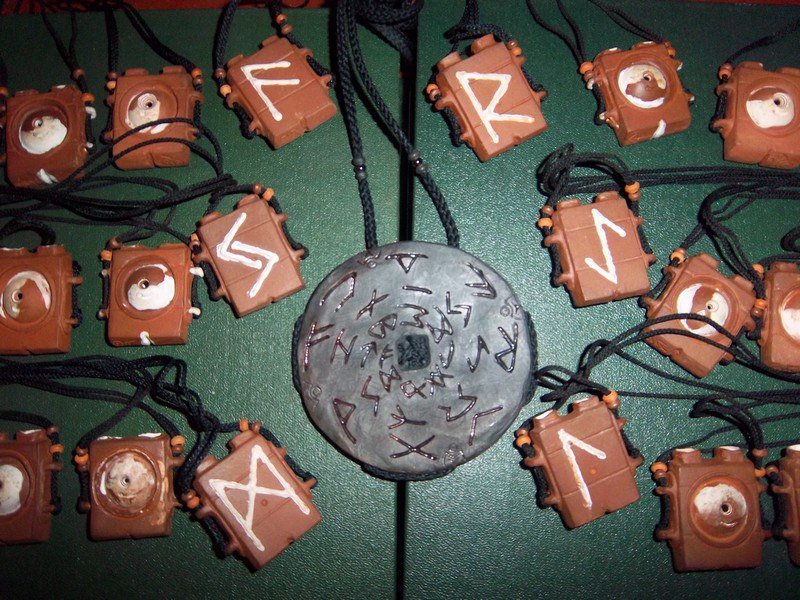
With the help of runes, they not only guess, they can heal and even protect themselves from trouble. Ways to use runes in the household are very different. Let's take a look at three of the most affordable.
Firstly, it would be nice to make amulets from runes. To do this, we select a suitable rune, for example, Bereginya, which will protect both from the evil eye and from diseases. Then we make an amulet out of it, simply by making a hole for the lace. Any material is used for the amulet, wood, stone and metal are ideal. The rune can be embroidered on clothes or woven from beads, as long as it is in contact with the skin all the time.
Second, homemade cakes with a sign Slavic rune- useful and tasty!
And, thirdly, we spread the sign of the rune with salt at the bottom of the bath and enjoy the magical runic water.
World
The form of the rune World is the image of the Tree of the World, the Universe. It also symbolizes the inner self of a person, centripetal forces striving the World towards Order. In a magical sense, the rune Peace represents protection, the patronage of the gods.
Chernobog
In contrast to the rune Mir, the rune Chernobog represents the forces pushing the world towards Chaos. The magical content of the rune: the destruction of old ties, the breakthrough of the magic circle, the exit from any closed system.
Alatyr
The rune Alatyr is the rune of the center of the Universe, the rune of the beginning and end of all things. This is what the struggle between the forces of Order and Chaos revolves around; the stone that lies at the foundation of the World; it is the law of balance and return to normal. The eternal circulation of events and their immovable center. The magical altar on which the sacrifice is made is the reflection of the stone of Alatyr. This is the one sacred image, which is enclosed in this rune.
Rainbow
Rune of the road, the endless path to Alatyr; a path determined by the unity and struggle of the forces of Order and Chaos, Water and Fire. The road is more than just movement through space and time. The road is a special state, equally different from vanity and rest; a state of movement between Order and Chaos. The Road has neither beginning nor end, but there is a source and there is a result... The ancient formula: "Do what you want, and come what may" could serve as the motto of this rune. magical meaning runes: movement stabilization, travel aid, favorable outcome difficult situations.
Need
Runa Viy - the god of Navi, the Lower World. This is the rune of fate, which cannot be avoided, darkness, death. Rune of constraint, stiffness and coercion. This is a magical ban on the commission of this or that action, and constraint in the material plane, and those bonds that fetter the consciousness of a person.
Krada
The Slavic word "Krada" means sacrificial fire. This is the rune of Fire, the rune of aspiration and the embodiment of aspirations. But the embodiment of any plan is always the disclosure of this plan to the World, and therefore the rune of Krad is also the rune of disclosure, the rune of the loss of the external, superficial - that which burns in the fire of sacrifice. The magical meaning of the Krada rune is purification; release of intention; embodiment and implementation.
Treba
Rune of the Spirit Warrior. The meaning of the Slavic word "Treba" is a sacrifice, without which the realization of intention is impossible on the Road. This is the sacred content of this rune. But sacrifice is not a mere gift to the gods; the idea of sacrifice implies the sacrifice of oneself.
Force
Strength is the property of a Warrior. This is not only the ability to change the World and oneself in it, but also the ability to follow the Road, freedom from the shackles of consciousness. The Rune of Strength is also the rune of unity, integrity, the achievement of which is one of the results of moving along the Road. And this is also the rune of Victory, for the Warrior of the Spirit gains Strength only by defeating himself, only by sacrificing his external self for the sake of releasing his inner self. The magical meaning of this rune is directly related to its definitions as a rune of victory, a rune of power and a rune of integrity. The Rune of Strength can direct a person or situation to Victory and gaining integrity, can help clarify an unclear situation and push for the right decision.
Eat
Rune of Life, mobility and natural variability of Existence, for immobility is dead. The rune is symbolizes renewal, movement, growth, Life itself. This rune represents those divine forces that make grass grow, earth sap flow through tree trunks, and blood run faster through spring in human veins. This is a rune of light and bright vitality and a natural desire for movement for all living things.
Wind
This is the rune of the Spirit, the rune of Knowledge and ascent to the top; rune of will and inspiration; the image of the spiritual magical Power associated with the element of air. At the level of magic, the rune of the Wind symbolizes the Force-Wind, inspiration, creative impulse.
Bereginya
Bereginya in Slavic tradition - female image associated with protection and motherhood. Therefore, the rune of Beregini is the rune of the Mother Goddess, who is in charge of both earthly fertility and the fate of all living things. The Mother Goddess gives life to souls who come to incarnate on Earth, and she takes life when the time comes. Therefore, the Beregini rune can be called both the rune of Life and the rune of Death. The same rune is the rune of Fate.
Oud
In all branches of the Indo-European tradition, without exception, the symbol of the male member ( Slavic word"Ud") is associated with the fertile creative force that transforms Chaos. This fiery force was called Eros by the Greeks, and Yar by the Slavs. This is not only the power of love, but also a passion for life in general, a power that connects opposites, fertilizes the emptiness of Chaos.
Lelya
The rune is associated with the element of water, and specifically - Living, flowing water in springs and streams. In magic, the Lelya rune is the rune of intuition, Knowledge beyond the Mind, as well as spring awakening and fertility, flowering and joy.
Rock
This is the rune of the transcendent unmanifested Spirit, which is the beginning and end of everything. In magic, the rune of Doom can be used to dedicate an object or situation to the Unknowable.
Support
This is the rune of the foundations of the Universe, the rune of the gods. The support is a shaman's pole, or a tree, along which the shaman travels to heaven.
Dazhdbog
The rune of Dazhdbog symbolizes the Good in every sense of the word: from material wealth to the joy that accompanies love. The most important attribute of this god is the cornucopia, or, in a more ancient form, the cauldron of inexhaustible blessings. The stream of gifts flowing like an inexhaustible river represents the rune of Dazhdbog. The rune means the gifts of the gods, the acquisition, receipt or addition of something, the emergence of new connections or acquaintances, well-being in general, and also the successful completion of any business.
Perun
The rune of Perun is the god of thunder, protecting the worlds of gods and people from the onset of the forces of Chaos. Symbolizes strength and vitality. The rune can mean the emergence of powerful, but heavy, forces that can shift the situation from dead center or give it additional energy development. It also symbolizes personal power, but, in some negative situations, power that is not burdened with wisdom. This is also a direct protection given by the gods from the forces of Chaos, from the destructive effects of psychic, material or any other destructive forces.
Source
For a correct understanding of this rune, it should be remembered that Ice is one of the creative primordial elements, symbolizing Strength at rest, potentiality, movement in stillness. The rune of the Source, the rune of Ice means stagnation, a crisis in business or in the development of a situation. However, it should be remembered that the state of freezing, lack of movement, contains the potential power of movement and development (signified by the rune There) - just as movement contains potential stagnation and freezing.
Slavic runes(runitsa) - the script that existed among the Slavs before their baptism and the invention of the Cyrillic and Glagolitic alphabets. Sometimes referred to as the letter "devils and cuts".
Evidence for the existence of the Runes
The first arguments in favor of the existence of the Slavic pynic writing were put forward at the beginning of the last century; some of the testimonies cited then are now attributed to the Glagolitic alphabet, and not to the "pynitsa", some turned out to be simply untenable, but a number of arguments remain valid to this day.
So, it is impossible to argue with the testimony of Titmar, who, describing the Slavic temple of Retra, located in the lands of the Luticians, points to the fact that inscriptions were made on the idols of this temple, made by "special", non-Germanic ryns. It would be completely absurd to assume that Titmar, being an educated person, could not have recognized the standard junior Scandinavian ryns if the names of the gods on the idols would have been inscribed by them.
Massydi, describing one of the Slavic temples, mentions some signs carved on stones. Ibn Fodlan, speaking of the Slavs of the end of the 1st millennium, points to the existence of grave inscriptions on pillars among them. Ibn El Nedim speaks about the existence of Slavic pre-Cyrillic writing and even cites in his treatise a drawing of one inscription carved on a piece of wood (the famous Nedim inscription). In the Czech song "Lyubysha's Judgment", preserved in the list of the 9th century, "desks pravdodatne" are mentioned - laws written on wooden boards in some letters.
The existence of pynic writing among the ancient Slavs is also indicated by many archaeological data. The oldest of them are finds of ceramics with fragments of inscriptions belonging to the Chernyakhov archaeological culture, unambiguously associated with the Slavs and dated to the 1st-4th centuries AD. Already thirty years ago, the signs on these finds were identified as traces of writing. An example of "Chernyakhovsky" Slavic pynic writing can serve as fragments of ceramics from the excavations near the village of Lepesovka (southern Volyn) or a clay shard from Ripnev, belonging to the same Chernyakhovsky culture and representing, probably, a fragment of a vessel. The signs visible on the shard leave no doubt that this is an inscription. Unfortunately, the fragment is too small to be able to decipher the inscription.
In general, the ceramics of the Chernyakhov culture provides very interesting, but too scarce material for deciphering. So, the Slavic clay vessel, discovered in 1967 during excavations in the village of Voiskovoe (on the Dnieper), is extremely interesting. Its surface is inscribed with an inscription containing 12 positions and using 6 characters. The inscription can neither be translated nor read, despite the fact that deciphering attempts have been made. However, it should be noted a certain similarity of the graphics of this inscription with the pynic graphics. There is a resemblance, and not only a resemblance - half of the signs (three out of six) coincide with the Futarka pyns (Scandinavia). These are the runes Dagaz, Gebo and a secondary version of the rune Ingyz - a rhombus placed on top.
Other - later - a group of evidence of the use of pynic writing by the Slavs is formed by monuments associated with the Wends, the Baltic Slavs. Of these monuments, first of all, let us point out the so-called Mikorzhinsky stones, discovered in 1771 in Poland.
Another - truly unique - monument of the "Baltic" Slavic ryniki is the inscriptions on cult objects from the Slavic temple of Radegast in Retra destroyed in the middle of the 11th century during the German conquest.
Origin
Like the pynes of the Scandinavian and continental Germans, the Slavic pynes go back, judging by all, to the North Italian (Alpine) alphabets. Several main variants of Alpine writing are known, which, in addition to the northern Etpysks, were owned by Slavic and Celtic tribes living in the neighborhood. The question of exactly how the Italic script was brought to the late Slavic regions remains to be seen. this moment completely open, as well as the question of the mutual influence of Slavic and Germanic pynics.
It should be noted that pynic culture should be understood much more broadly than elementary writing skills - this is a whole cultural layer, covering mythology, religion, and certain aspects of magical art. Already in Etpyria and Venice (the lands of the Etpysks and Wends), the alphabet was treated as an object of divine origin and might have a magical effect. This is evidenced, for example, by finds in the Etpysian burials of tablets with a list of alphabetic characters. This is the simplest form of pynic magic, widespread in the North-West of Europe. Thus, speaking of the Old Slavic rynic writing, one cannot but touch upon the question of the existence of the Old Slavic rynic culture as a whole. Slavs of pagan times owned this culture; it was preserved, yudya by all, and in the era of "dual faith" (simultaneous existence of Christianity and paganism in Russia - 10-16 centuries).
An excellent tomy example is the widest use by the Slavs of the Freyra-Ingyz rune. Another example is one of the remarkable Vyatich temporal rings of the 12th century. Signs are engraved on its blades - this is another sign. The third blades from the edges carry the image of the Algiz rune, and the central blade is a double image of the same rune. Like pyna Freyra, pyna Algiz first appeared in Futark; it existed without changes for about a millennium and entered into all pynic alphabets, except for the late Swedish-Norwegian ones, which were not used for magical purposes (about the 10th century). The image of this pyna on the temporal ring is not accidental. Runa Algiz is a rune of protection, one of its magical properties is protection from other people's witchcraft and the evil will of others. The use of the Algiz rune by the Slavs and their ancestors has a very ancient history. In ancient times, four Algiz runes were often connected in such a way that a twelve-pointed cross was formed, which apparently has the same functions as the rune itself.
However, it should be noted that such magic symbols may appear among different peoples and independently from each other. An example of a volume can be, for example, a bronze Mordovian plaque of the end of the 1st millennium AD. from the Army cemetery. One of the so-called non-alphabetic pynic signs is the swastika, both four- and three-branched. Images of the swastika in the Slavic world are found everywhere, although infrequently. This is natural - the swastika, a symbol of fire and, in certain cases, fertility - a sign too "powerful" and too significant for widespread use. Like the twelve-pointed cross, the swastika can also be found among the Sarmatians and Scythians. Of extraordinary interest is the one-of-a-kind temporal ring, again Vyatka. On its blades, several different signs are engraved at once - this is a whole collection of symbols of ancient Slavic magic. The central blade carries a somewhat modified Ingyz line, the first petals from the center are an image that is not yet completely clear. A twelve-pointed cross is applied to the petals second from the center, which is most likely a modification of the cross of four Algiz runes. And, finally, the extreme petals carry the image of a swastika. Well, the master who worked on this ring created a powerful talisman.
Rune interpretation
World
The form of the rune World is the image of the Tree of the World, the Universe. It also symbolizes the inner self of a person, centripetal forces striving the World towards Order. In a magical sense, the rune Peace represents protection, the patronage of the gods.
Chernobog
In contrast to the rune Mir, the rune Chernobog represents the forces pushing the world towards Chaos. The magical content of the rune: the destruction of old ties, the breakthrough of the magic circle, the exit from any closed system.
Alatyr
The rune Alatyr is the rune of the center of the Universe, the rune of the beginning and end of all things. This is what the struggle between the forces of Order and Chaos revolves around; the stone that lies at the foundation of the World; it is the law of balance and return to normal. The eternal circulation of events and their immovable center. The magical altar on which the sacrifice is made is the reflection of the stone of Alatyr. This is the sacred image that is enclosed in this rune.
Rainbow
Rune of the road, the endless path to Alatyr; a path determined by the unity and struggle of the forces of Order and Chaos, Water and Fire. The road is more than just movement through space and time. The road is a special state, equally different from vanity and rest; a state of movement between Order and Chaos. The Road has neither beginning nor end, but there is a source and there is a result... The ancient formula: "Do what you want, and come what may" could serve as the motto of this rune. The magical meaning of the rune: stabilization of movement, travel assistance, a favorable outcome of difficult situations.
Need
Runa Viy - the god of Navi, the Lower World. This is the rune of fate, which cannot be avoided, darkness, death. Rune of constraint, stiffness and coercion. This is a magical ban on the commission of this or that action, and constraint in the material plane, and those bonds that fetter the consciousness of a person.
Krada
The Slavic word "Krada" means sacrificial fire. This is the rune of Fire, the rune of aspiration and the embodiment of aspirations. But the embodiment of any plan is always the disclosure of this plan to the World, and therefore the rune of Krad is also the rune of disclosure, the rune of the loss of the external, superficial - that which burns in the fire of sacrifice. The magical meaning of the Krada rune is purification; release of intention; embodiment and implementation.
Treba
Rune of the Spirit Warrior. The meaning of the Slavic word "Treba" is a sacrifice, without which the realization of intention is impossible on the Road. This is the sacred content of this rune. But sacrifice is not a mere gift to the gods; the idea of sacrifice implies the sacrifice of oneself.
Force
Strength is the property of a Warrior. This is not only the ability to change the World and oneself in it, but also the ability to follow the Road, freedom from the shackles of consciousness. The Rune of Strength is also the rune of unity, integrity, the achievement of which is one of the results of moving along the Road. And this is also the rune of Victory, for the Warrior of the Spirit gains Strength only by defeating himself, only by sacrificing his external self for the sake of releasing his inner self. The magical meaning of this rune is directly related to its definitions as a rune of victory, a rune of power and a rune of integrity. The Rune of Strength can direct a person or situation to Victory and gaining integrity, can help clarify an unclear situation and push for the right decision.
Eat
Rune of Life, mobility and natural variability of Existence, for immobility is dead. The rune is symbolizes renewal, movement, growth, Life itself. This rune represents those divine forces that make grass grow, earth sap flow through tree trunks, and blood run faster through spring in human veins. This is a rune of light and bright vitality and a natural desire for movement for all living things.
Wind
This is the rune of the Spirit, the rune of Knowledge and ascent to the top; rune of will and inspiration; an image of a spiritualized magical Power associated with the element of air. At the level of magic, the rune of the Wind symbolizes the Force-Wind, inspiration, creative impulse.
Bereginya
Bereginya in the Slavic tradition is a female image associated with protection and maternal origin. Therefore, the rune of Beregini is the rune of the Mother Goddess, who is in charge of both earthly fertility and the fate of all living things. The Mother Goddess gives life to souls who come to incarnate on Earth, and she takes life when the time comes. Therefore, the Beregini rune can be called both the rune of Life and the rune of Death. The same rune is the rune of Fate.
Oud
In all branches of the Indo-European tradition, without exception, the symbol of the male member (the Slavic word "Ud") is associated with the fertile creative force that transforms Chaos. This fiery force was called Eros by the Greeks, and Yar by the Slavs. This is not only the power of love, but also a passion for life in general, a power that connects opposites, fertilizes the emptiness of Chaos.
Lelya
The rune is associated with the element of water, and specifically - Living, flowing water in springs and streams. In magic, the Lelya rune is the rune of intuition, Knowledge beyond the Mind, as well as spring awakening and fertility, flowering and joy.
Rock
This is the rune of the transcendent unmanifested Spirit, which is the beginning and end of everything. In magic, the rune of Doom can be used to dedicate an object or situation to the Unknowable.
Support
This is the rune of the foundations of the Universe, the rune of the gods. The support is a shaman's pole, or a tree, along which the shaman travels to heaven.
Dazhdbog
The rune of Dazhdbog symbolizes the Good in every sense of the word: from material wealth to the joy that accompanies love. The most important attribute of this god is the cornucopia, or, in a more ancient form, the cauldron of inexhaustible blessings. The stream of gifts flowing like an inexhaustible river represents the rune of Dazhdbog. The rune means the gifts of the gods, the acquisition, receipt or addition of something, the emergence of new connections or acquaintances, well-being in general, and also the successful completion of any business.
Perun
The rune of Perun is the god of thunder, protecting the worlds of gods and people from the onset of the forces of Chaos. Symbolizes strength and vitality. The rune can mean the emergence of powerful, but heavy, forces that can move the situation off the ground or give it additional development energy. It also symbolizes personal power, but, in some negative situations, power that is not burdened with wisdom. This is also a direct protection given by the gods from the forces of Chaos, from the destructive effects of psychic, material or any other destructive forces.
Source
For a correct understanding of this rune, it should be remembered that Ice is one of the creative primordial elements, symbolizing Strength at rest, potentiality, movement in stillness. The rune of the Source, the rune of Ice means stagnation, a crisis in business or in the development of a situation. However, it should be remembered that the state of freezing, lack of movement, contains the potential power of movement and development (signified by the rune There) - just as movement contains potential stagnation and freezing.
Material from the free Russian encyclopedia "Tradition"
LETTER LETTERS
Introduction
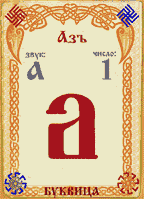 In this article, we will study the Old Russian language and, in comparison with it, Old Slovenian. The main emphasis will be placed on grafting the firstfruits figurative thinking, and not on phonetics and morphology, as in academic textbooks on the Old Church Slavonic language. Why is that? The phonetic reading of ancient initial letters does not give access to understanding the information (meaning) contained in readable text. After all, the ancient languages are not so much a system of reading, but, basically, a system of extracting the hidden meaning from these texts. The uninitiated perceive everything written literally, and those who know the “keys” perceive what is encrypted. Therefore, phonetic reading is not a “key” to understanding depth, but only a sound designation readable characters which gives us an existential understanding of the ancient text and nothing more.
In this article, we will study the Old Russian language and, in comparison with it, Old Slovenian. The main emphasis will be placed on grafting the firstfruits figurative thinking, and not on phonetics and morphology, as in academic textbooks on the Old Church Slavonic language. Why is that? The phonetic reading of ancient initial letters does not give access to understanding the information (meaning) contained in readable text. After all, the ancient languages are not so much a system of reading, but, basically, a system of extracting the hidden meaning from these texts. The uninitiated perceive everything written literally, and those who know the “keys” perceive what is encrypted. Therefore, phonetic reading is not a “key” to understanding depth, but only a sound designation readable characters which gives us an existential understanding of the ancient text and nothing more.
When reading phonetically, we are, as it were, sliding over the surface of the information array, not being able to go to the depth. And any superficial knowledge is considered incomplete, distorted, i.e. lies. In the understanding of the ancestors, “lie” (bed - phonet.): located on the surface (on the bed) - distorted, not full information about anything.
To understand something in depth, you need to master not a combination of letters, not spelling, but connection of images, connection in essence: why it is said this way, but it is different, and what is the meaning of this verb. We are always trying to tie the image to specific words, concepts. It is necessary to realize that it is not the phonetic representations of what we call the “word” that are connected, but the images. What these uniform images give rise to new single images, which, in contact with new images, give rise to even newer images. Therefore, each image, connecting with another image, creates new image, generating more and more new images that unite, responding to the call of your speech, your thought. You call them and they come. You connect them with others, and more, and more... The result is a system EDUCATIONS - vocation of the image, education (I) nie, creation, and not a system of training through coaching. And when you have learned to create images, then your brain switches to figurative thinking, figurative worldview, figurative worldview.
This will be the most correct: you need to know the basis in order to understand everything else. And it is not at all accidental that until 1917 initial education without fail gave knowledge of the basics of the Old Slavonic language. This was the beginning of education, i.e. the ability to connect and understand the meaning of letters and words. And without this skill (key), which gives access to ancient texts, the rest of the training was considered meaningless.
The Russian language was and still remains the language of images. deep meaning, in contrast to European ones, which give a superficial (in breadth) understanding of the transmitted information.
In the very structure simple words The Russian language contains fundamental knowledge about everything. And anyone who knows Russian can remember them. Only the study of the deep Russian language (images) and open communication with native nature able to awaken the genetic memory and save the psyche from numerous "zombie" programs.
Our language has retained the basic mechanisms of native speech (figuration) by about 30-40%. The languages of other peoples - for percentages and fractions of a percent. There are languages that are almost completely built not on figurative principles, but on virus-bacterial codes. The words of the first speech have been preserved in different languages, but in each a little. Therefore, not all words need to be tried to be interpreted, because they are not real, but conditional contractual symbols, in which there is no figurative conceptual meaning.
At modern man due to the simplification of the language and the loss of figurative thinking, many processes of the brain are damaged and inhibited. The brain of our ancestors worked far from the modern 3%, because. The first speech was informative and fast paced. Therefore, it was very different from the current systems of communication. True, the mechanisms of transmission and processing of information in the human brain have not fundamentally changed. Images are formed in the brain thanks to frequency sound codes that have their own matrix - a letter that has its own image. Two letters, connecting, form a new image (slogan).
The figurative (slogan) construction of ancient mental speech provides for many synonymous words and options for the assembly sequence, because the task of the brain is to draw a holographic image of an object that is understandable. Despite the great differences between different language groups, the brain retains the holographic principle of operation - imagery, at least at the level of internal communication between brain regions. When conducting experiments on speech zone of the brain, it turned out that no matter how people of different nationalities break languages, their brain pronounces words and communicates “in Russian” between its departments. This once again shows that a white man comes from a single Genus and a single "nationality".
We can understand an image as a set of versatile knowledge that combines into a specific description of an object or phenomenon. Each image carries a deep essence, which makes it possible to understand the purpose and existence of this image.
The etymology of this word is far from clear. At S. Ozhegova : result; perfect shape displaying objects and phenomena of the material world in the human mind; appearance, appearance; type, character; order; the direction of something, etc. At V. Dalia : portrait, whose likeness, police, written face, icon. At Slavs , in addition to everything else: voluminous wooden figures of the Gods (kummirs).
Reading the word image» in the meaning of initial letters, also gives many etymological options:
- double ( about) single ( once-one) create ( b);
- O n B ogami R nice az;
- etc.
The imagery of ancient Slovenian, and later Old Russian, comes from the runes with which our ancestors reflected the reality around them. A rune is not a letter, not a syllable. And those philologists who believe that they can read the runic text are deceived. They pick up only tops, unaware of the roots, like a character famous fairy tale. Rune - a secret (ultimate, deep) image of that phenomenon, event, which was displayed in the runic inscription, its essence. Each sign of the same Sanskrit, a simplified form of x, the Aryan Karuna, has up to 50 meanings. Original, i.e. Karuna (union of runes), over 144. Therefore, the decoding of these texts was carried out, obviously, not by amateurs, but by professionals who had the gift of connecting and understanding runic image path(darrungs).
The graphemes of Karuna and the Holy Russian Initial letter were written under the so-called “celestial” (“divine” - by Mirolyubov) line, but the images that they carried in themselves often did not coincide. They were superimposed on the public text (simple reading), using it as a medium. In order to identify the desired image embedded in the text, in addition to “simple reading”, three more, so-called “deep readings” (step-by-step decoding) were carried out. The result of each stage became the "key" to the transition to the next stage. All four readings were combined into a single text (simple reading - everyday wisdom; deep readings - a higher order of wisdom). And vice versa: the deep information of the matrix. It turned out a kind of "information matryoshka" for general use. Ordinary people repeated it in chants, hymns, glorifications of the Gods from century to century. So simply and reliably ensured the safety of information over time. And among the priests were kept "keys" to decipher the ancient wisdom. Such was general form saving knowledge in the past.
And now let's show by example principle extracting information. You, of course, know the expression "primary truths." In the modern sense, this is something very simple, even primitive, known to everyone. For example, like 2x2 or like a, b, c, d, e, f, f, g, s, h(phonetic beginning of the alphabet) - Stage 1.
But the letters (letters) used to have names: az, Gods (beeches), lead, verbs (verb), good, eat, am, belly, green, earth - stage 2.
Combining the names of initial letters in pairs and adding their well-known images, we get a text familiar to many: I know God, speaking good, saying good is being, life is great on earth - Stage 3.
We go down deeper, moving on to the deep images of initial letters: I know a lot, multiplying information about being, which is a form of existence of diverse life on earth(planets) - Stage 4.
It is necessary to remind over and over again that the vast and mighty state of Rus (Rasseniya, Svyatorus) had great story and culture, the memory of which has been humiliated for more than a century. In these lands was the very source ancient faith humanity: Vedic, and therefore it is here that one should look for the origins of the very culture of writing graphemes that carry figurative meaning. The very one that our ancestors brought from the north from Daaria (Arctida), starting from the four most powerful primary sources of graphic display of sounds, which already at that time had an incredible temporal duration of their development and unity for us.
What is Rus' in Vedic times was united and had a high cultural level, says the indisputable existence of the great, unified Old Russian language, which has a more developed phonetics, grammatical structure than the modern Russian language. Now there is, as already mentioned, the impoverishment (degradation) of our language. For example, simplification of pronunciation letters (throat, nasal, hissing, whistling, etc.) led to the fact that verbal combinations tested over millennia ceased to affect our body (for dialect s, on dialect s), because they are now pronounced with the wrong frequency, vibration.
All the "reforms" of the last centuries were aimed at its primitivization, simplification, loss of imagery. The initial letter had 49 characters. Before Peter, 6 letters were removed from it. Peter himself brought their number to 38. Nicholas II and the Bolsheviks settled on 33 letters. And they already say that further simplification is inevitable if we want to live by European standards. But who proved that their locale is higher? They have already reduced it to 24 letters! It has already been said about the loss of deep imagery in European languages, especially in English, which is being strongly pushed to the role of the world language leader.
Example: many authors studying the Old Russian and Old Slavic languages note their conciseness due to the additional transmission of the image. The expression " prince come". We understand it to this day. In English, these two words were rendered in 11 words. In our language, all other words from English translation according to the rules are considered weed words. So think about whether we need such a "leader" and such "reforms"?
In conclusion, we can state that with the loss of figurativeness and the transition to a phonetic way of extracting information, our language has become without O ugly and ultimately ugly A hot. “The death of a language means the death of the Genus,” said one Armenian thinker in the last century. Distorted language leads to distorted perception, from which distorted values arise, distinctions are lost - in will and desire, form and formality, goodness and benefit, capacity and volume, etc. Genus loses its qualities and degrades (runs wild), turns into a people ( on foliation Genus a), from which, if the process continues, originates sb genus (Sat orny genus).
It has been noticed that closed human communities, cut off from civilization, are gradually switching to a primitive language, and even the inhabitants of neighboring villages cease to understand each other. Something similar is observed in Western Europe. Residents of various regions in Germany, Finland, for example, already speak dozens of dialects and do not understand each other well.
To stop or, for starters, slow down the process of running wild, you need to return to your roots, figuratively speaking. And for this you need to know the language of your fathers, Schurs, ancestors. And not only to know, but to be, to become their full-fledged heirs, having mastered the word in full.
In order to build the existence with a word, and not to destroy it, depriving it further of the Image, whereby moving farther and farther away from the Rule, and closer to Navi.
Our current language is only shadow ancient language. How to put two eggs side by side, and they do not differ in anything in appearance, but only one is whole, and the other is eaten .... From the outside, it's the same thing, but there is no longer any content in one. The trail has caught cold ... Our goal now is to find in the "shadow" of that sprout of the not killed Ancient Language and grow it anew. This work is not easy, it is hard, but, as Bobrok Volynsky used to say in his time: “ Hold on, brothers!»
Until the roots withered, remind the tree of Childbirth
To all whose traces have caught a cold, that they were born in Russia!
With fury, the Gods give them the salt of the age-old road,
To step foot in the memory of past centuries.
Well, who does not understand, does not remember,
The wind will remind you.
And reflected in the lake Essence - a reflection of the truth.
They will come to the rick with earnestness: they are cursed, cursed! Released!..
In Iznovi
Still, the light shines.
Chapter 1: Types of writing
Long before the Christianization of the Rasichi ("Indo-Europeans" modern science) had many types of writing, about which Catherine II, attached, as the ruler of the empire, to secret information about the past, bluntly stated that the Slavs had their own writings many thousands of years before Christ. Notice, not a letter, but writing, i.e. different kinds written diploma. A similar point of view was expressed by M. Lomonosov, V. Tatishchev, E. Classen. But such views were held and held by not all, as they are expressed, " language schools". Basically, historical science, by hook or by crook, imposes on society the idea that before Christianization, the Slavic Russians did not have their own writing. Nowadays, only “features and cuts” are recognized, and even then under the pressure of numerous finds of samples of this Slovenian folk writing. Everything else is rejected, being immediately declared "a fake, fake, nationalist nonsense."
Let's not get involved in a fruitless discussion about the mission of the "solunsky brothers", because. The well-known historian N.I. Kostomarov gave an assessment of their activities. For us, it is more important that the Russian Orthodox Church initially knew that the Slavs had their own script (in ecclesiastical- the historical dictionary for 1889 clearly states on this occasion: “The Rosses, a Varangian tribe, lived in southern Russia; with Byzantium they either did trade or fought. Borrowed letters from them St. Cyril.), but preferred not to advertise her knowledge too much. This is politics, which at all times was considered an unclean activity. It is she who is to blame for the fact that the largest ethnic group in Europe has been denied identity for a century: anyone and anything, but not the Slavs (especially the eastern ones). Is it not here, as they say, that the dog is buried? Such a psychological (magical) technique our ancestors called "averting eyes", i.e. switching attention to something that does not correspond to reality. They (the Greeks) said that set us writing to we accepted her and lost their. But remember that Ilar (Kirill), who wanted to teach our children and had to hide in our homes so that we would not know that he teaches our letters, and how our gods need to put it" (Vleskniga / Patriarsi).
 There is a catalog of part of the runic manuscripts from the library of Anna Yaroslavna, which, after long vicissitudes, ended up in the possession of the well-known collector of the 19th century, archaeologist A.I. Sulakadzev. This catalog mentions two editions of the "Book of Veles": Yagily Gan smerd from Ladoga ("Patriars") and Olekh Visherts from Cherdyn ("Krinitsa") - "about the resettlement of old-timers and the first faith." There were also “Kolyadnik of the 5th century of the Danube Yalovets about worshiping the Troy mountains, about fortune-telling in the caves”, “Volkhovnik” manuscript of the 6th century, “Traveler” of the 4th century, “Perun and Veles broadcasting in Kiev temples to the priests of Moveslav, Drevoslav and others” ( 5.6 centuries), etc.
There is a catalog of part of the runic manuscripts from the library of Anna Yaroslavna, which, after long vicissitudes, ended up in the possession of the well-known collector of the 19th century, archaeologist A.I. Sulakadzev. This catalog mentions two editions of the "Book of Veles": Yagily Gan smerd from Ladoga ("Patriars") and Olekh Visherts from Cherdyn ("Krinitsa") - "about the resettlement of old-timers and the first faith." There were also “Kolyadnik of the 5th century of the Danube Yalovets about worshiping the Troy mountains, about fortune-telling in the caves”, “Volkhovnik” manuscript of the 6th century, “Traveler” of the 4th century, “Perun and Veles broadcasting in Kiev temples to the priests of Moveslav, Drevoslav and others” ( 5.6 centuries), etc.
An excerpt from the Sloven Veda, published by S. Verkovich in 1874: “... our grandfathers of that time were the most scientists on earth, and all the others came to ask the teachers how and what to do ... They (Greeks) from us and the plow taught, and learned crafts, and reading, and writing ... When our ancestors lived in the Land of the Earth (Daaria - Arctida?), Zhiva Yuda came and taught how to write golden tablets to the Garden-King ... There were many books of that faith ... There were such books in everyone village in Daspod (Bulgaria - ours), until the Gentiles came ... and began to burn those old books. But now no one is pulling it out, but hiding it in hiding places.
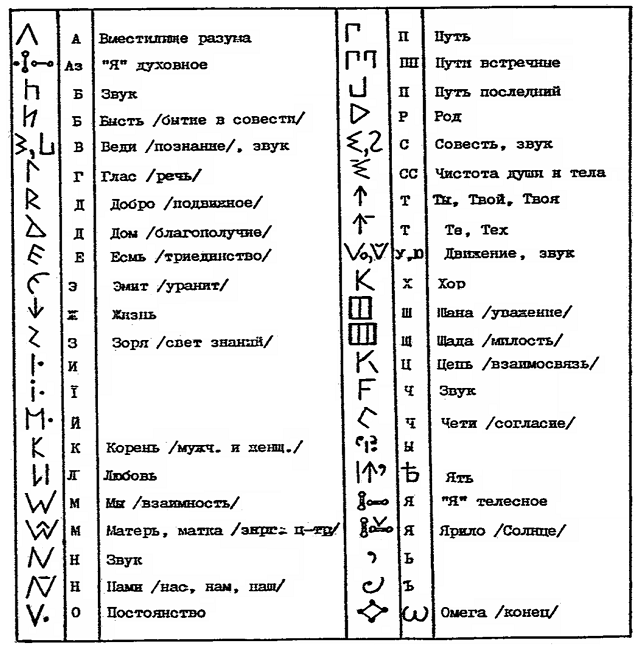 A number of other well-known sources also testify to the existence of writing among the Slavs. For example, the Bulgarian monk Khrabr (10th century) in his treatise “On Writing” reports: “before, I don’t have books, but with devils and cuts to chtyahu and gadaahu ...”, literally: before the Slovenes did not have books, but features and they wrote with cuts and explained their entire existence.
A number of other well-known sources also testify to the existence of writing among the Slavs. For example, the Bulgarian monk Khrabr (10th century) in his treatise “On Writing” reports: “before, I don’t have books, but with devils and cuts to chtyahu and gadaahu ...”, literally: before the Slovenes did not have books, but features and they wrote with cuts and explained their entire existence.
The Arabs also talked about the presence of original writing in Rus' (ibn Fadlan, al Masudi, ibn Yaqub el Nedim). The German chronicler, Bishop Titmar of Merseburg, saw in one of the Slavic churches in the city of Retra, on the island of Rugin (Rügen), several kummirs, on which their names were inscribed with signs. AD and a stone inscription from the Sea of \u200b\u200bAzov, taken by him from the book of F. Volansky. This alphabet is undoubtedly one of the variants of the alphabetic-runic writing of our ancestors, who settled in the vast expanses of ancient Eurasia. Comparing the inscriptions of the letters of the alphabet and the stone inscription, we find an undeniable similarity between them.
“Potshemosia chiria opeze gradizhid tazhdiyakoluniya sdrugia zeliya nehey yaatvgya in the face of nehey lelia of nehey living light.” What now sounds like: “we will try to build a house with sincere care, as well as a farmstead for young spouses. Let children be born and cherished, and let life be bright.
The book of the Kazakh scientist K. Akishev "Kurgan Issyk" says: ancient monument written language (VI - V centuries BC) on the territory of Kazakhstan... Specialists in the ancient languages of the East believe that the Issyk inscription was made in an alphabet not yet known to world science. Such a conclusion suggests that this alphabet was invented by the Saks of Semirechie or related tribes on the basis of some kind of writing, most likely Aramaic. But what certified linguists could not do, writes G. Maidantsev, was done by the Russian inventor I. Kuznetsov. In 1981, he read this epitaph with the help of a "leather": " And I was looking for Arsatan Peshchur, who was all in vain”, i.e. “And there was also Arsatan Ancestor, who vigilantly defended everything.”
The well-known linguist and epigraphist V.A. Chudinov, on the issue of the existence of pre-Cyrillic writing among the Slavs, writes that “he read a lot of ancient inscriptions. Of course, this is a small fraction of the wealth that was published by archaeologists (but for some reason not claimed by historians as an evidence base). However, even these examples make it possible to see that writing not only existed, but permeated all layers of Russian society…”. The important conclusion that the scientist makes is that age Slavic writing, judging by the discovered samples, exceeds hundreds of thousands of years. And that this is so is demonstrated by a find at the Berehat-Ram site (Israel) in 1981. In the layers of petrified lava (233-800 thousand years ago), an anthropomorphic tuff figurine was discovered, on which, with a strong increase, Chudinov found inscriptions read in Russian.
 Linguist N.G. Samsonov, analyzing the facts of mass finds of birch bark letters in Novgorod, Pskov, Smolensk, Vitebsk, notes, “that such a spread of literacy also indicates that by the 11th century. Russian writing has come a long way in development before becoming a habit, a need... One might think that pre-Christian writing was quite perfect.”
Linguist N.G. Samsonov, analyzing the facts of mass finds of birch bark letters in Novgorod, Pskov, Smolensk, Vitebsk, notes, “that such a spread of literacy also indicates that by the 11th century. Russian writing has come a long way in development before becoming a habit, a need... One might think that pre-Christian writing was quite perfect.”
And before proceeding to a direct analysis of the types of writing, let's give one more quote from L.N. Ryzhkov's book "On the antiquities of the Russian language": look for its true appearance... This implies a shift of the pre-literate and written era for the Russian language into the depths of millennia, since now written monuments that were not previously considered monuments of Russian and Proto-Slavic writing are involved in consideration.
Therefore, Russian (and generally Slavic) lexical modernity may well turn out to be the glorious past of Old Latin, Proto-Iranian, Proto-Sanchrist, etc. before their degradation changes ... Apparently, the Old Slavic vocabulary is the source of the most ancient primary language of Indo-European studies. The source of the continuity of cultures is the Slavic syllabary, from which all European alphabets originated in the process of its collapse.
According to the Vedas, the written literacy of the Slavic-Aryan peoples was based on four forms of writing, from which all other types of alphabets and alphabets subsequently originated.
They wrote in those days on tablets made of wood, clay, metal, as well as on parchment, fabric, birch bark, papyrus. They scratched with metal and bone pointed rods (wrote) on stones, plaster, wooden buildings. In 2000, a book consisting of wooden pages was found in Novgorod - an analogue of the "Vlesovaya book". She was given the name "Novgorod Psalter", because. it included the famous texts of the three psalms of King David. This book was created at the turn of the 10th and 11th centuries and is the most ancient book Slavic world from recognized official science.
“The appearance of a new source of information about the events of a thousand years ago always looks like a miracle. After all, it is hard to believe that for several centuries of studying the written heritage of our ancestors, something significant could have escaped the attention of scientists, something significant was noticed, appreciated, for example, monuments of Russian runic. And would you like to notice? After all, the presence of the same runic contradicts the position of inert official science, proving that the Slavs before baptism were a young tribe, and not a people with ancient culture(“Return of the Russian runic.” V. Torop.).
Another first-class find of domestic historians was the pre-Cyrillic text, which received the conditional name "extensive edition of Boyanov's anthem." The text, consisting of the 61st line, has suffered quite a lot from time to time. The protograph underlying it was restored, and it got its own name - Ladoga document.
In 1812, Derzhavin published two runic excerpts from the collection of the St. Petersburg collector Sulakadzev. Until our time, the mystery of the published passages remained unsolved. And only now it turns out that the lines torn out of the abyss of oblivion by Derzhavin are not fakes, as would-be scientists have assured us for so many years, but unique monuments of pre-Cyrillic writing.
The Ladoga document allows us to draw an important conclusion. The Russian runic had a fairly wide circulation and was used not only in the circle of priests to record such sacred texts as the "Patriarsi" (Vlesov's book). Ladoga and Novgorod, of course, were not some unique literacy centers in Rus'. Russian runic signs were found on the antiquities of the 9th-10th centuries from Belaya Vezha, Old Ryazan, Grodno. The text from the Derzhavin archive is a surviving evidence of a written tradition that once existed everywhere.
The end of the document is full of names. The forms of these names are unique and are found only in the text of "Patriarsi": Blre - Bolorev, Dor, Otuarih - Otoreh, Eruek - Erek, Nobubsur - Nabsursar, etc. In our passage, as in "Patriarsi", the Rus are identified with "Kimry", that is, the Cimmerians. The names of Rus' are also close: Borusen - Bar.
The reasons for the appeal of the "koba" (priest) to ancient historical legends are noteworthy. In the north, Christian squads appeared, bringing death to the pagan world. But, besides the armed confrontation, there was also an ideological one. Christian priests of that time denied historical value Slavic past. For them, these were ages of barbarism and idolatry.
“Kob” called some kind of Christian writing a pseudo-literacy and in response to it gave a cursory overview of Russian history, starting from the era of the Cimmerian Rus’s stay in the power of the Babylonian king Nabopolassar (7th century BC). Here is an excerpt from this historical account:
Wildebeest kobe suite
chreti ide vorok ldg proud
mlm grub rota as a slave a garusera kb speech prupupe gnu mmu kbi str mzhu term chaa lie grmtu
kimru rusa and before kimra rodu vrgu room and you stilhu
blrv dor voi be mkom bu vrvu Gruk by birth otuarich do izhodrik do false erueku warrior
and kltmu aldorog
mru dei burn svove god archie grdniku
Vchna brous on kostechu stav strade bar to doriu nobubsur.
Lord holy cob:
Christians go to Ladoga-city.
We pray, we make sacrifices so that the farmers will not be enslaved and the city will not be destroyed.
I send Perun's speeches to my master, cob-old man
I send to my husband, waiting for the cherished term, against false letters.
The Rus were Kimry and lived before the Kimry
Were enemies of Rome and you, Stilicho;
Bolorev; Dir-warrior was our torment, he was a barbarian, and by birth - a Greek;
Otuarih, then Izhodrik, then the deceitful Rurik the warrior;
damned Aldorog - they sowed death, burned our god, killed the townspeople.
Eternal Rus', stands on the bones,
suffering from the times of Dir and Nabopolassar.
This passage is connected with the text "Patriarchy" not only by names. If in one source Dor (annalistic Dir) is called a barbarian Greek origin, then in another - half-Greek, half-barbarian. Chronicles, however, incorrectly attribute Dir, like many others actors early Russian history, to the Varangians.
The commonality of the information of both runic monuments speaks volumes. The antiquity of the historical tradition underlying them before early XIX century (the date of the Sulakadze copy), makes the very idea of falsifying the "Patriarsi" ridiculous. At the time of Sulakadzev, practically all the information contained in the Patriarchy was unknown to science. Christian chroniclers wrote about the pagan Slavs about the same thing as today: “... I live in a bestial way, I live like a beast, and I kill each other, eating everything unclean, and many have had marriage...».
Kob opposed such reasoning. The authors of "Patriarchy" also stood up for the honor Slavic people. On one of its plates we read: “Askold is a dark warrior and only enlightened from the Greeks that there are no Ruses, but there are only barbarians. This can only be laughed at, since the Cimmerians were our ancestors, and they shook Rome and drove the Greeks away like frightened piglets. The Ladoga document ends with a description of suffering Rus'. The same thing is said in the Patriarchy: "Rus' is a hundred times broken from north to south." But in the "Patriarchy" we find a continuation of the thought that broke off in the document in mid-sentence: "Three times fallen Rus' will rise."
How relevant this ancient prophecy is today! Derzhavin set an example of successfully resisting the destruction of our memory. Until his last days, the great son of the Russian people fought to save the Russian runic and eventually won. Miraculously surviving pages open to us Slavic civilization no less ancient and no less rich than the civilization of any other people.
Chapter 2: Approaching the Drop Cap
« The signs are different, the language is the same”, - this is how P. Oreshkin wrote, finishing his work on deciphering ancient written monuments. He suggested to specialists in world and Russian history: "The door is open, come in!". But few heard it. The rest preferred to plug their ears and close their eyes, because "The light is destructive for them."
We repeat his call: “Come in, good people! The door is open". Let's start comprehending the figurative content of our language, like schoolchildren, by studying two forms of writing letters and words: the Old Slovenian (Old Slovenian) “Letter Cap” and the Old Russian “ABC”, i.e., as they say, from the very beginning. But " AZ"In the figurative understanding of our ancestors, in addition to everything else, there is" a source, a beginning ( A) bases, systems ( h) the ability to create, create ( b)”, but not something primitive in the modern distorted perception.
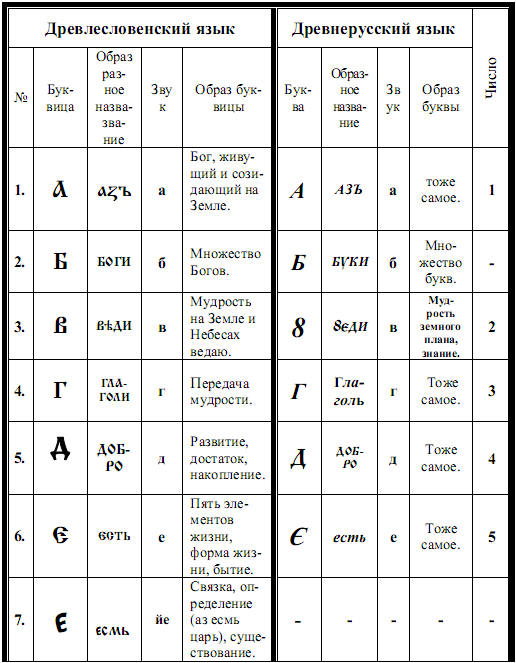
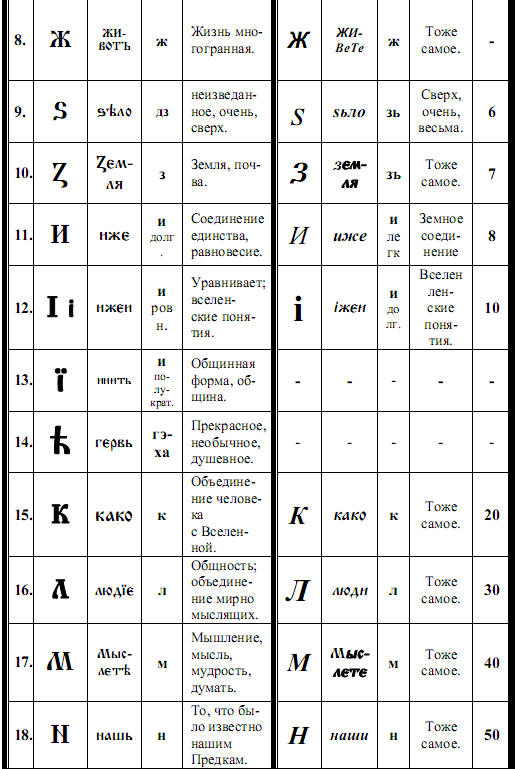
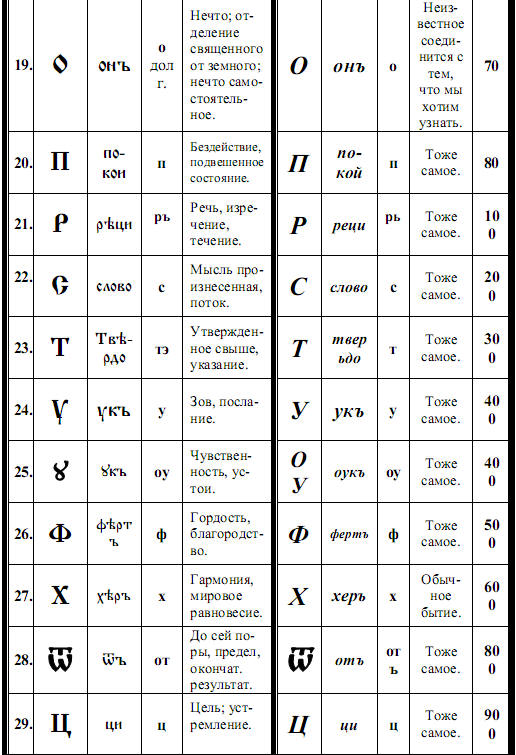
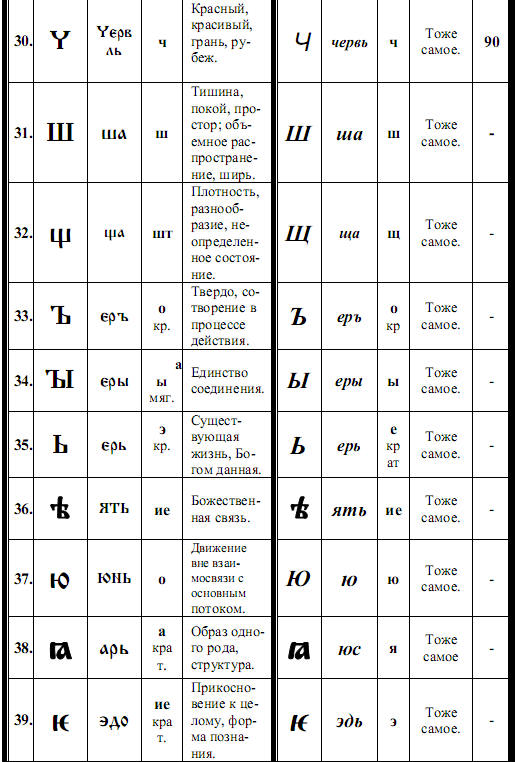
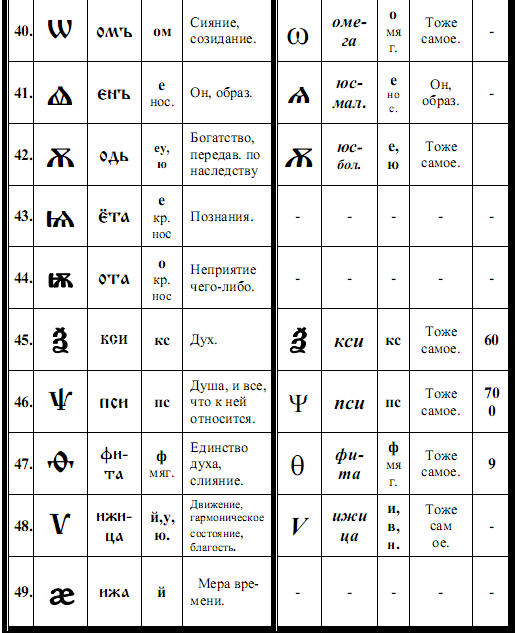
C a w y a b u k t w e a (letter ) v d a n d n o t a bl i t e m e t i o n s, Part which are n o m e r o u t o o o o o o o o o o o o o.
S oe d i the o n i o n i o n i o n i o n i o n i o n i o n i o n i n t i o n i n t o n t o r t o t in a way, although the phonetics of the word can remain the same. form 19 1 7 n e s n a n a n and g about izvedeniya iyaL. N . That l hundred g about writing a l about stak:
"In ynai M Ї ръ» , i.e. "In ynai People". Now:" In yin ai world» , i.e.
"Wo yna and n ev oin a”, which, you see, diverges from the writer’s point of view.
Etoges l o v osb k vit e y "izh it a": M V R o-b u r e
(V specifically about the case) .
P W a r e : AND- vn and cha l if about va; IN- all ere d inesl o wa; H- in the end. S LA VE V (S LA VE n) ,when you are a god, goodness. With LAVE Nb-g we are talking about everyday life: a person vexla ventru d om, for example.
Mi r - sun elensk Yastruktura. M æ r ъ (m y rъ) - at ka for n ienach a s -
ti t u r y (chrono van t? ) even in the scripture: a way to move time from the past to the future. and asserted that there is no past, no future, no future, but only one - n about those lives the present, which r o e r lives on US(costs), and navse ile i n i ro d a to which we belong. Therefore, the mums of the present, with full right, say:
" WE we built it, we won it," although this may have been the result of the wealth of our town. From the beginning to the present n their times n-m w in the d n o r n o r n o u r n o r t o r e s . (youtube) CH07ox70s_g(/youtube) http://www.youtube.com/watch?v=CH07ox70s_g
Those who read the dictionary of Dahl, Nikievsky - this is an interpreter of the 15th century - if anyone is engaged - there are such concepts there. One of the concepts of "language" is people. The representative of the people is "pagan". A representative of an alien people, with other ways of thinking, with other rites of life - this is "no tongue", abbreviated as "pagan". Therefore, speaking in simple Soviet language, a pagan is a non-believer and a foreigner, a representative of a foreign people, a foreign language, a foreign culture. Now in the schools of Belarus, Ukraine, Serbia, Montenegro, Macedonia, not to mention Russia, the term is being inculcated that before Christianization in these states, on the territory Great Rus', Red Rus', Silver Rus' and Pomeranian Rus', paganism was everywhere. That is, for the Christianizers, yes, there was heterodoxy and other people, but for those who lived in these Vesy, there was Native Culture everywhere, built on Tribal Foundations, on Tribal Wisdom, that is, on FAITH. Therefore, an attempt now to create new neo-pagan organizations in order to lead the Slavs away from their roots is quite natural. Speech by Fr. Alexandra on Krasnodar TV GTRK Kuban in 2000.Kolovrat. Transfer Kitchen GTRK Kuban (2000) (Watch the full version)
GAMES OF THE GODS Act 7.4 Living Fire. ABC Truths
Lomonosov M.V. (1711 - 1765) Stills from Kh/F (1984-1986)
In what a fierce struggle was it introduced into Russian society XVIII century Miller-Romanov version of Russian history.
Lomonosov, Mikhail Vasilyevich - one of the greatest Russian poets and scientists (1711 - 1765). genius scientist mid-eighteenth V. - is one of the founders of science in Russia. Being a remarkable physicist and chemist, he was also successfully engaged in astronomy, geology, geography and linguistics, everywhere leaving a brilliant trace of his genius. In addition to scientific achievements, Lomonosov became famous as a poet and writer.
(youtube)PQ2y_tB_Seg(/youtube)
www.youtube.com/watch?v=PQ2y_tB_Seg




